(This section includes graphic novels, graphic books and comics).
Elon Musk: portrait d’un nouveau maître du monde.
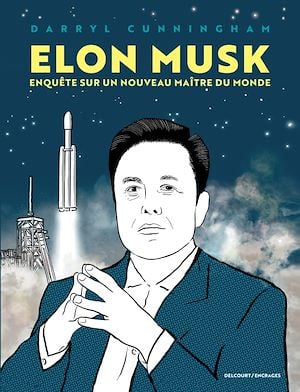
The Musk family
I appreciate real-life stories, and especially investigations that study human behaviour. Reading this graphic novel in French about Elon Musk, one grasps the character’s high level of initiative. He likes risking a lot when creating a new company. This characteristic is also present in the family genealogy, starting with the grandfather. However, they clearly act without concern for social norms.
Elon’s main desire is to use his talent and creativity to influence the course of the world, particularly when it comes to the Internet, renewable energies and space. As well as mentioning Musk’s successes, the graphic novel also highlights the grey areas that are too often overlooked.
Considering that mankind will one day colonize space, Elon Musk looked to buy a rocket, but they were all too expensive. So he created Spacex and a team of Spacex scientists invented a rocket named Falcon 1, which the company succeeded in launching into orbit after six years’ work. In 2011, Spacex built the world’s first reusable rocket. A year later, the Falcon 9 equipped with a Dragon capsule refuelled the International Space Station (ISS). In light of this success, the government reinjected another $440 million into Spacex for development. I write “another $440 million” because this was not the government’s initial investment in the firm.
Companies narrowly saved
As we read the book, we realize how many times Musk’s businesses have come close to disaster, only to be narrowly saved by perseverance, lots of luck, top-level government relations and whimsical promises.
Just think of Tesla and Spacex, two endangered companies that were spared from bankruptcy by a sudden injection of public money in the form of a $1.6 billion contract from NASA. This was preceded and followed by substantial loans from the US government: “Without the support of American taxpayers, Musk’s fortune would not exist.”
The book also mentions a possible fraud, as the SEC (Securities and Exchange Commission) filed a complaint for misleading tweets about Tesla. These tweets were said to have pushed up the share price by 6%. A settlement was reached a week later between Musk and the SEC. On this subject, Musk neither admits nor denies the allegations. “Musk and Tesla had to pay a fine of $20 million each and Musk had to step down as Chairman of Tesla’s Board of Directors for three years while remaining CEO.”
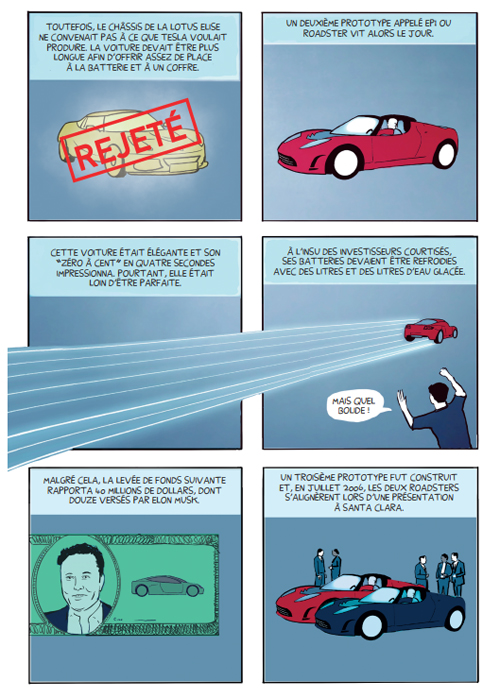
Whimsical Promises or Unfounded Announcements
Musk has talent when it comes to touting his products. But the author specifies this: “There’s no denying that Musk is determined, intractable and possesses a real gift for self-promotion. That said, he’s not an inventor, let alone a scientist.”
The book lists a number of whimsical promises, while pointing out that the media help Musk by passing on information that is not systematically verifiable or proven. The result is that the average reader is left with the impression that Elon Musk developed Spacex and Tesla all by himself: “The legend of the self-made billionaire will always be more seductive than the banal reality”.
As an example of whimsical promises, Musk announces that all battery recharging will be free for the Tesla Model S. This is nothing but hot air. He also declares that a Tesla will drive autonomously between Los Angeles and New York in 2017. At the time of writing, no such promise has materialized.
He also made other daring statements in 2016 when he founded Neuralink. This company has been criticized because the research it funds is poorly controlled. According to the book, it generates unnecessary animal suffering. In 2024, Elon Musk reveals that “his company has successfully implanted a device capable of ‘reading thoughts’ in an individual’s brain […]”. He gives no details of the location of the operation or the results.
Musk also makes unfounded statements about vaccination and the virulence of Covid-19. While he declares that this virus has a very low mortality rate and that he will not be vaccinated, the WHO announces in 2023 that the planet is at over three million deaths. He changes his mind and gets vaccinated. But what effect have his words had on recalcitrant Americans?
Elon Musk, Twitter and X
“Since its takeover by Musk, Twitter (or rather ‘X’) has been a tool for promoting the interests, prejudices and conspiracy theories of the right-wing parties of the American political class. This bias has brought a tidal wave of racism, anti-Semitism, climate skepticism, LGBTQ+ hate and medical fake news to the site.”
Elon Musk and Long-Termism
Long-termism and the colonization of various planets are themes dear to Elon Musk. Here’s what the book has to say about it: “Long-termism is an extremely dangerous ideology. It’s a secular religion built around the worship of ‘future value’ whose ethos absolves you from worrying about threats like climate change and global poverty, while making you a good person because you care about the future of humanity as a race that has conquered other planets.”
“No one should have the discretionary power that Elon Musk enjoys, because he hasn’t earned it and he doesn’t owe it to himself alone. He doesn’t understand how much his success owes to privilege and luck. As a result, he thinks he’s much smarter than he really is.”
Elon Musk and US President Donald Trump
If the attitude and decisions that characterize Elon Musk in entrepreneurship are transposed to the state, they could undermine the American president’s aspirations regarding his vision of American politics and the actions to be taken in the face of future challenges.
For example, Musk is known for avoiding confrontation with the Chinese president, as China is Tesla’s second-largest market. But Trump didn’t hesitate in his first term to impose substantial tariffs on China. Musk has also “directly interfered in Ukraine’s fight against Russian invasion”. The strategic interests of the two individuals could diverge significantly at times.
But it must also be considered that the actions of the two men could come into phase, which would mean far more rapid and far-reaching upheavals than anticipated.
One thing is certain: the Trump/Musk duo’s solutions to America’s problems will surprise observers of the political and economic scene. The Musk family has never been concerned about the dust they kick up when it comes to pushing their ideas forward. And Trump’s reductive analysis of the cause of America’s problems will do nothing to reassure the various national and international players. This can be seen in his current comments on Greenland, the Panama Canal and Canada.
The countries targeted by this duo’s initiatives will have to expect anything, and use their creativity, fighting spirit and composure to impose respect and restraint.
Title: Elon Musk—Enquête sur un nouveau maître du monde.
Author: Darryl Cunningham
Publisher: Delcourt/Encrages, © 2024
ISBN: 978-2-413-08612-3
Deux filles nues.
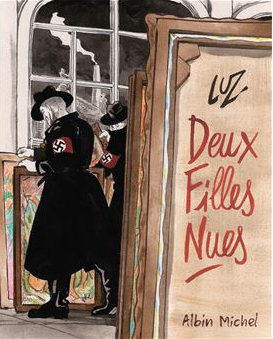
German painter Otto Mueller created the painting “Deux filles nues (Two nude girls)” in 1919. Through an artwork which survived turbulent times, the reader follows a changing Germany. He also gets to know the different art dealers.
At the beginning of the book, the author uses a great deal of imagination to introduce us to the life of the Mueller couple. The painter died in 1930 and the painting changed hands for the first time three years later. At that time, inflation was raging in Germany, and the dissatisfaction of the population led to the appointment of Adolf Hitler to the chancellorship by Hindenburg.
Between 1933 and 1946, the painting miraculously survived censorship and the destruction of works deemed degenerate by the Nazis. Thousands of works of modern German art were set on fire by the authorities.
Pogroms spread across Germany. Jewish-owned paintings were seized. When the Gestapo forced part of Ismar Littmann’s (German link, English link) collection to be auctioned off , it selected 64 works, 53 of which were immediately burned.
During the same period, a traveling exhibition entitled “Entartete Kunst” (“Degenerate Art”) was commissioned by Joseph Goebbels, and 730 works traveled between Munich and other major German cities. Ironically, this degenerate art ended up attracting three times as many visitors as acceptable German craftsmanship, whose works were displayed in nearby buildings.
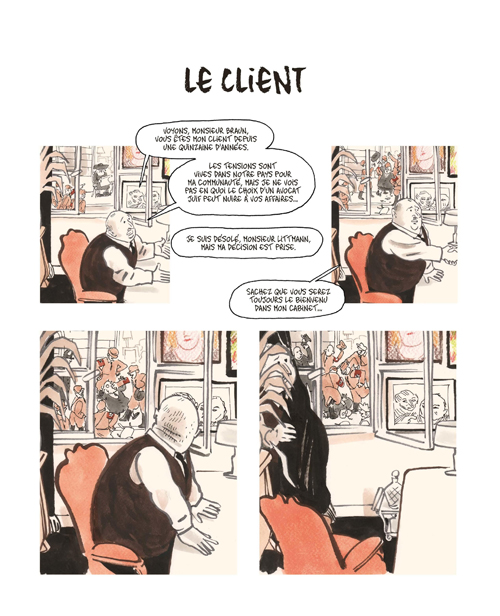
Until 1946, the painting “Deux filles nues” changed ownership several times, and continued to survive the bombings, organized destruction and art thefts carried out by the Nazis.
After the war, the painting’s name was changed from Zwei Mädchenakte (“Two Nude Girls”) to Zwei weibliche Halbakte (“Two Female Half-Nudes”) and toured Germany and the world. In 1976, it was exhibited at the Ludwig Museum in Cologne. Former owners Ruth and Chaim Haller were finally reunited with their painting in 1999. Ruth is the daughter of Ismar Littmann, mentioned at the beginning of this article.
The museum officially returned the work to the owners, but in the same year made an offer to buy it back, which was accepted by the Hallers. Today, the painting can be found in the Expressionist section of Cologne’s Ludwig Museum.
Through his considerable research and the publication of his graphic novel, the author underlines the importance of remaining alert to the political and cultural censorship that regularly resurfaces.
The book ends with a chronology of events and biographies of the main characters. The author goes to great lengths not to show us what the painting “Two Naked Girls” looks like, until we’re practically at the end of the story! A very clever way of keeping our curiosity alive.
Title: Deux filles nues
Author: LUZ
Publisher: Albin Michel, © 2024
ISBN: 978-2-226-48957-9 (French)
La fortune de Poutine
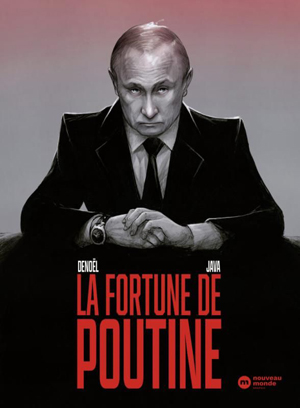
This graphic novel in French on Putin’s fortune recounts the events surrounding Vladimir Putin‘s rise to power and the establishment of his personal fortune. The latter is built through the exfiltration of colossal sums belonging to the Russian people, which are redirected to shell companies and tax havens.
As the story spans several decades, the reader becomes familiar with a multitude of company names and key political and economic figures.
As in the case of other major powers, there are also political and economic wheeling and dealing.
Russia’s power structure differs from that of the West. Relationships with the president play a much more important role than in the West. Benefits are granted in exchange for unwavering loyalty. The links between Silvio Berlusconi and Putin are just one example.
The scale of outflows of money from Russia for discreet purposes is astonishing. To cite just one example, the author notes the creation of Operation Luch (a capital flight estimated at $50 billion) in 1990 to counter the changes brought about by Gorbachev. This involved dipping into secret KGB funds abroad to enrich a fund that could be used to ensure the survival of the party and other vested interests.
“Since Putin came to power, the total amount of dirty money taken out of Russia and laundered through Western banks has been at least $1,000,000,000 (one thousand billion dollars)!
So, the West’s hands are not clean when it comes to what’s going on in Russia. When there’s quick money to be made and shareholders expect an unreasonable balance sheet, virtue takes a back seat to practicality. European accomplices include Danske Bank (Denmark), SEB and Swedbank (Sweden), Crédit Suisse, Banca Intesa (Italy), Deutsche Bank Russia, Appleby-Estera (offshore services firm), Cyprus (financial services firms), Price Waterhouse Coopers.
The reader also notes the accumulation of suicides by all kinds of officials over the years. For example, the author notes the disguised suicides of Nikolai Kruchina, Georgy Pavlov and Dimitri Lissovolik. These men, with their precarious balance, all had the annoying habit of taking the air on a balcony too high for their capacity. The KGB doubted the reliability of these men, who managed the party’s secret funds in the West.
Poisoning (with the poison Novitchok) is also a favored method for ironing out political differences. But this state of affairs is already well known to Westerners, as most failed or successful operations are the subject of numerous articles in the media. For example, this was the case for Navalny and Skripal. For Yushchenko, the winner of the Ukrainian presidential elections, dioxin was used but the source was not confirmed.
Under Putin, the oligarchs can keep the fortunes acquired through the many privatizations, but there is no longer any question of them interfering in political affairs. The book also looks at the deteriorating relationship between Putin and oligarchs such as Berezovsky (found hanged in his London bathroom) and Khodorkovsky.
If a devoted collaborator changes sides, at best he can survive by leaving the country and remaining apolitical. Otherwise, his plane may explode in flight, as in the case of Prigozhin.
The book shows how Ivan Rybkyn, a political opponent of Putin’s in 2004, withdrew after an impromptu van ride. It seems that he was seized and forced into the vehicle. This experience and the likely discussions that took place during the ride were enough to convince the candidate that he wasn’t really cut out for politics.
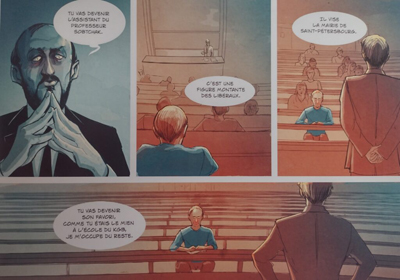
In the 90s, the Tambov mafia clan protected Putin and Sobchak and helped run the port of St. Petersburg. This did not prevent a “road accident” involving Vladimir Putin’s daughters and wife. Those dissatisfied with their share of the cake raised the stakes, and Putin had to bring the families together to work things out between them. Pragmatically, he sent his daughters to Germany for their safety. The legal guardian was Matthias Warnig, a former STASI officer.
The author points out that Russian money was used to influence the Brexit result (51.89%), this with the aim of weakening Europe. Then, as we already know, Russia influenced the voting result in key US states to help elect Donald Trump.
The graphic novel ends with a documentary dossier, with photos, drawings and references for those who want more information.
What about Putin’s fortune? According to the authors’ research, it’s between 150 and 250 billion euros.
Title: La fortune de Poutine (Putin’s fortune)
Authors: Yvonnick Denoël and Gildas Java
Publisher: Nouveau monde graphic, © 2024
ISBN : 978-2-38094-501-0
Carcajou

The “Carcajou (Wolverine in English)” graphic novel is one of the best buys I’ve made this year. The authors have created an almost perfect work, in terms of scenario, graphics and colors.
The vast forests of Alberta, a large province in western Canada, provide the backdrop for this tale. The reader meets a number of colorful characters trying to make their way in this wild environment. Not everyone has what it takes to adapt, but that’s the reality of life in the developing outback.
By 1895, Alberta was attracting gold prospectors and businessmen interested in oil development. Some territories were acquired more or less ethically, and the natives lost out. However, their ancestral beliefs persisted despite injustice and unequal power relations.
The authors tackle a number of significant themes in the development of Canada’s history: the lack of respect shown to First Nations, the harmful effects of alcohol in remote areas, the courage and tenacity required of women to impose respect, the violence caused by firearms, and a police force that sometimes gets involved in crime.
All these aspects developed by less talented authors would produce a negative storyline. The genius of the authors is to have developed the story in a very dynamic way, while still conveying essential messages. There’s no real break in the action. The plot keeps the reader on his toes right to the end.
I loved the characters and clever plot of “Carcajou” and recommend this superb work to graphic novel fans.
Title : Carcajou
Authors : Eldiablo et Djilian Deroche
Edition: Sarbacane, 2024
ISBN : 978-2-377-31792-9
Le murmure de la mer.
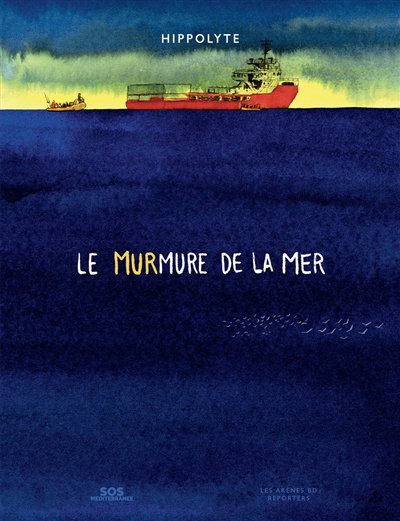
The graphic novel “Le murmure de la mer” is a tribute to the work of the Ocean Viking’s crew, the rescue ship belonging to the SOS Méditerranée group. Its mission is to rescue migrants leaving North Africa, particularly the Libyan inferno.
Those refugees find themselves overcrowded on makeshift boats, drifting endlessly in the middle of the sometimes raging Mediterranean Sea. Often, the rafts brush up against Libyan oil platforms. Day and night, the coast guards pursue the migrants and brutally drag them back to Libya.
After a first blocked attempt to participate in a rescue, the author climbs aboard the Ocean Viking in 2020 as a journalist, cartoonist and crew member. He’s directly involved in the salvage operations, and recounts his experience in a series of beautiful sketches and touching photos.
Readers appreciate the great discipline and preparation required to carry out salvage missions in an orderly and safe manner for all concerned. Sentimentality has no place when rescuing migrants in crisis. Not following procedures can result in further deaths, including those of crew members.
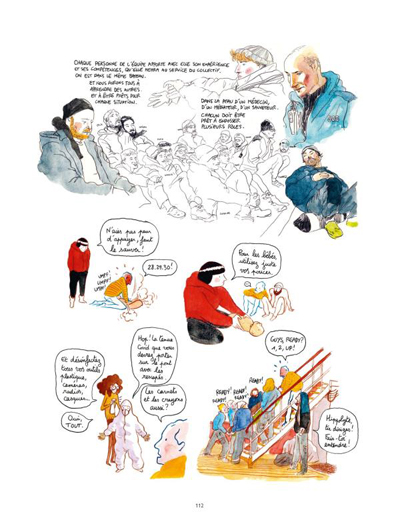
We bear witness to the crew’s successes and failures in their attempts to rescue as many people as possible. The sailors of the Ocean Viking face administrative blockades from Italy, which seeks to limit the considerable arrival of refugees.
First among these attempts to hinder rescue operations is the obligation for the ship to remain docked for long periods for different reasons.
Next is the requirement to transfer the new migrants to ports far from the Ocean Viking’s position. These ports are deliberately chosen by the Italian government to generate fuel costs and lengthy delays between each recovery mission. This drag prevents thousands of refugees from being salvaged.
We must, however, question the involvement of other states when it comes to admitting migrants. The misfortune of people living in countries disadvantaged by ruthless dictatorships, climate change or poverty accelerated by the plundering of wealth is everyone’s responsibility.
Once the refugees are on the boat, the crew still has to secure them, care for them and prepare them for transfer to their next land of welcome. We all know the story of those vessels which have picked up hundreds of Africans in difficulty, and which remain immobilized for weeks while awaiting clearance to transfer the survivors to a new territory. Yet the law of the sea states that any ship’s captain who learns that human beings are in peril on a body of water must render assistance.
In short, a fascinating and informative read. It increases our understanding of the challenges faced by crews helping humans in danger on the Mediterranean Sea.
Title: Le murmure de la mer
Author: Hippolyte
Publisher: Les Arènes, Paris, 2024.
ISBN: 979-10-375-1156-0
Sept vies à vivre.
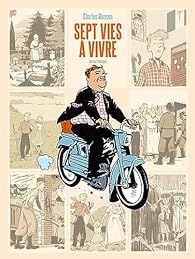
For a long time, I hesitated to buy this graphic novel, which was only available in one of the seven bookshops I regularly visit. In this age of flashy covers and attention-grabbing themes, I found myself faced with this quiet book about the seven lives of a complete stranger. What was I to do?
In the end, I decided to buy it and found it so interesting that I read it in one go. A very nice surprise, although I should have known that the quality would be there when I saw the name of the author, Charles Masson. I had previously read another very interesting graphic novel by this author. The book was entitled “Droit du sol” and dealt with the difficulties experienced by natives in dealing with colonialism.
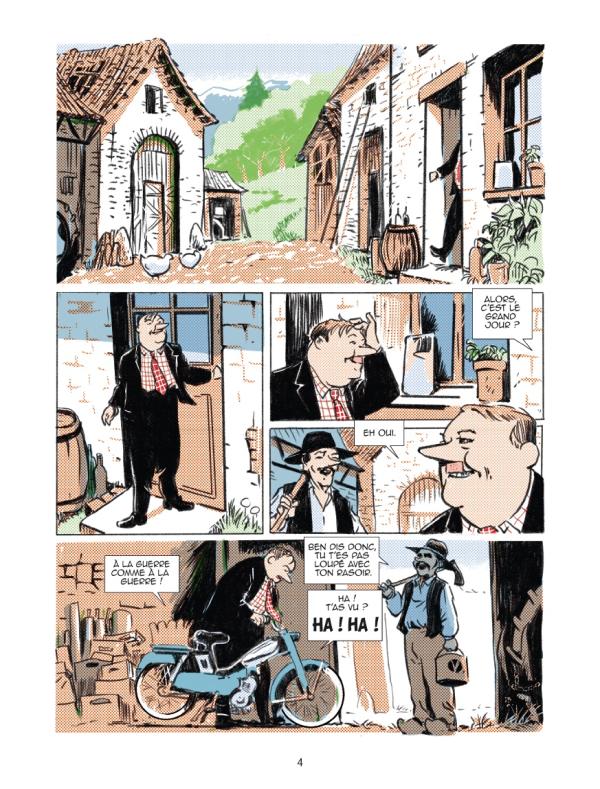
“Seven Lives to Live” is an intelligent and humane account of the life of an ordinary man named René. Forget computers and social networks. The reader finds René and his family several decades ago in the Bauges massif, where he spent his childhood and adolescence in the absence of comfort and luxury. The inhabitants toil to survive in this part of the country.
René lost seven siblings in infancy and is determined to live life to the full. He heads down to the valley to change his life. René’s seven lives are the seven great moments that change this man’s destiny. Like so many of us, he was shaken by events. In his case, it’s the Second World War, compulsory military training in France in 1946, chance encounters, and so on. How do you adapt and retain your humanity in the face of life’s surprises?
The script is solid and the graphics interesting. There’s no downtime, which is something to be said for a 225-page story. A great find to add to your library.
Title: Sept vies à vivre
Author: Charles Masson
Editions: Delcourt/Mirages
© 2024
ISBN: 9 782 413 077 060
Wagner – l’histoire secrète des mercenaires de Poutine
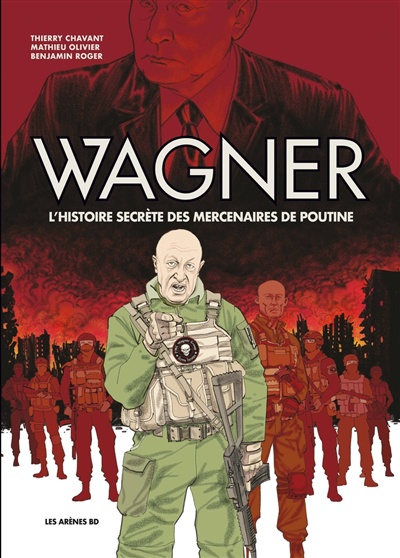
“Wagner” is a top-quality graphic novel, the fruit of serious research based on numerous known and confidential sources.
Thanks to the large concentration of relevant data in a single volume, readers will quickly gain a better understanding of the international role played by this mercenary group supported by Vladimir Putin, which has gradually established itself in Mali, the Central African Republic, Libya and Syria, before attacking the Ukrainians.
The book includes the names of numerous companies, corporations and foundations (Concord, IRA [Internet Research Agency], SEWA Security Services, Lobaye Invest, M-Finance, M-Invest, Meroe Gold, Midas Resources, First Industrial Company, International Global Logistic [IGL], Alpha Development, Marko Mining, Prime Security, etc.) and a host of players who played a major role in sharing control of natural resources (mines, forests, etc.) in the Central African Republic and Mali.
The book shows how the short-sightedness of certain politicians and intelligence services enabled Wagner to gain a foothold in Africa without too much difficulty. It sheds light on the hasty departure of the French in Mali and the Chinese south of Bamako.
African leaders and customs officials turn a blind eye to the transfer of gold and diamonds to Russia. But I don’t have to dig very far in my memory to point out that many great powers have enjoyed similar treatment in other places on our beautiful planet.
Scriptwriter and illustrator Thierry Chavant is careful not to over-censor the actions of Wagner’s mercenaries, who sometimes think of themselves as soldiers. The explicit drawings shed light on the crimes committed by these killers, including rape, torture and the systematic elimination of hundreds of people at a time.
Despite these radical methods, the mercenaries do not have it easy against determined opponents. Wagner lost many fighters to the jihadists in Africa, but far fewer than in Ukraine, where the group suffered a literal debacle, with tens of thousands killed and wounded.
Even Yevgeny Prigozhin and Dmitry Utkin lost their lives when the private jet they were in exploded over Russia. The question I still ask myself today: how can anyone be so stupid as to continue to fly calmly over Russia after having tried to seize power by force a few weeks earlier?
The book confirms that international geostrategy has two faces: an acceptable side, where diplomats and businessmen work hard to gain advantages for themselves or their countries. But there’s also a much more violent side, where the main principles give way to the desire to win new territories with the wealth they contain. And there, any means are good enough to achieve the goal, be it obscure financing, threats, summary executions, overthrowing governments or even modern-day slavery.
Title: Wagner
Investigation: Matthieu Olivier and Benjamin Roger
Script and drawing: Thierry Chavant
Colour: Mathilda
Authors: Thierry Chavant
Publisher: Les arènes BD
© 2024
ISBN: 979-10-375-1111-9
L’expert
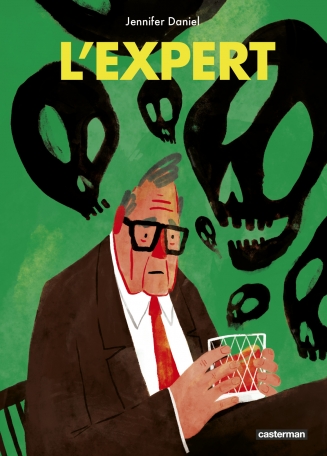
The story takes place in 1977 in West Germany. A road accident that claims the lives of a woman and her child attracts the attention of a morgue employee, a man with high standards of professionalism and who is well regarded by his general manager.
This employee is Monsieur Martin, a former soldier who once fought in the Second World War and for whom the word “responsibility” weighs heavily in his existence as an older man. He conducts his own investigation, and naturally upsets people in high positions who have decided to look the other way to preserve their reputations.
Such a theme will always be relevant, as it affects not only German society but all nations across the planet, where individuals who have the most to lose in a given situation choose to disregard their obligations, despite the injustices.
The graphic novel “L’expert” is very well done. I like the drawings, the scenario, the choice of colours, the period and the location where the story takes place. The Germans must certainly have appreciated its publication in 2022.
Title: The Expert (original German version as “Das Gutachten”)
Author: Jennifer Daniel
Publisher: Casterman, ©2024 for the French translation. Original German edition Carlsen Verlag GmbH, © 2022.
ISBN: 978-2-203-28080-9
Brüsel
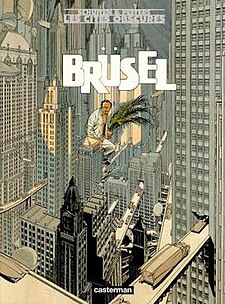
Brüsel will delight fans of well-crafted comics. There’s everything in this book: top-quality graphics, attention to detail, an overflowing imagination on the part of the authors, a little humor and sensuality, a touch of cynicism.
We find ourselves with familiar themes, but developed backwards from common sense to pique the reader’s curiosity. Society will be saved by the advent of plastics, a veritable revolution. And we’ll finally be able to get rid of the plants we have to look after, which wither away and constantly need a little water.
The authors also take an original approach to the deterioration of hospital care. The script shows us a patient who is always promised incredible treatments by a doctor whose reputation is beyond reproach. However, no intelligent action is taken, and the patient gradually recovers from the lack of treatment.
The hero of the story and an employee he meets by chance form an unconventional duo and take us into the twists and turns of a city in the making that a megalomaniac is designing without consulting the citizens.
The few people appointed to obey the wishes of a single man walk around with scaled-down buildings under their arms and place here and there the skyscrapers of the future city. It’s all decided behind closed doors and in the interests of a few, as sometimes happens in city planning.
In short, if you’re looking for a story and graphics out of the ordinary to escape from déjà vu, this is the comic for you.
Title : Brüsel
Authors : Schuiten-Peeters
© Casterman, 2023
ISBN : 978-2-203-27639-0
Le piège américain – The American Trap
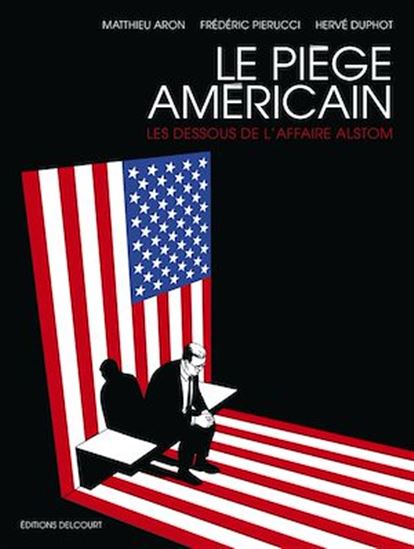
Frédéric Pierucci is a senior executive at Alstom, a gigantic French energy company. Thanks to a US extraterritorial law (FCPA Foreign Corrupt Practices Act) which allows the US government to prosecute any foreign firm targeted for corruption, he was arbitrarily arrested in 2013 as he got off the plane in New York.
Pierucci had not received any money from these operations, but he was aware that Alstom was targeted for embezzlement and that the company used “intermediaries” to secure contracts. He was incarcerated for months, and Alstom finally abandoned him, believing that the Americans would be satisfied with the imprisonment of this high-ranking executive. Pierucci must now try to extricate himself from the quagmire into which he has been plunged.
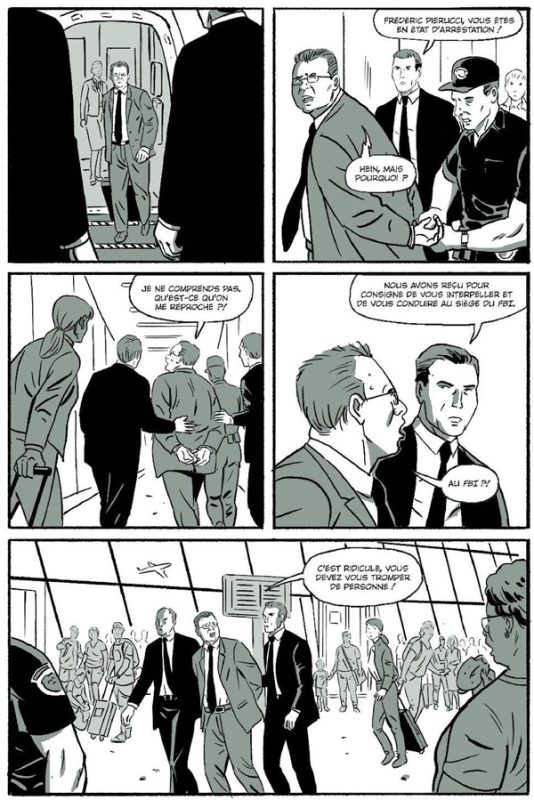
Even if he is not directly implicated in the bribes, the American justice system wants to pressure Pierucci into revealing details that would incriminate Alstom’s management, including CEO Patrick Kron. Pierucci’s harsh judicial treatment is also intended to intimidate the firm’s other top executives, showing them what awaits them if they do not cooperate in rectifying past mistakes.
The primary aim seemed to correct unfair schemes that were damaging American companies and, by the same token, to obtain very substantial monetary compensation. The operation was a success: the effects of Pierucci’s arbitrary arrest paved the way within a few years for the sale of a strategic Alstom subsidiary to General Electric, its main competitor.
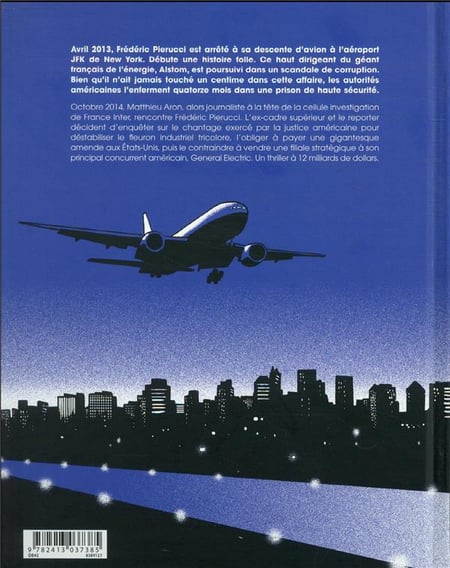
The maneuvers also allow to obtain information that would otherwise remain confidential. This U.S. extraterritorial law works well and is used to attack numerous corporations around the world, including the German international group Siemens. Each time, the offender is obliged to pay substantial fines and must submit internal documents considered confidential or even secret to the prosecutor.
It’s hard to know who exactly will have access to these documents. Is it possible that agents (we won’t call them “spies” for the sake of politeness) are passing on trade-secret information to people working outside the U.S. Justice Department? Such actions would enable American companies to improve their competitiveness at little cost. But these are questions that the executives of the targeted companies are asking themselves.
Be that as it may, not everything in this story is squeaky clean. Author Matthieu Aron writes: “In autumn 2018, after Frédéric [Pierucci] was finally released, we finished our book. But again, it was not without difficulty. The day after we sent our manuscript to our publisher, my home was ‘visited’ and my computer disappeared. Simple burglars, spooks, or action by a foreign service? We’ll probably never know.”
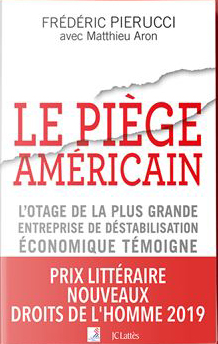
My view on the subject.
China is watching and learning.
The effectiveness of this American extraterritorial law has not escaped the attention of China, which is planning to devise a similar law that would allow it to lay its hands on otherwise inaccessible information and archives.
Faced with these two behemoths, the United States and China, Europe has fallen behind, and it too will have to create its own law enabling it to extend its judicial power outside the continent. For no one is fooled: bribes to obtain contracts involve multiple countries. Prosecutions under extraterritorial legislation give access not only to large sums of money, but also to documents containing important data and possibly industrial secrets.
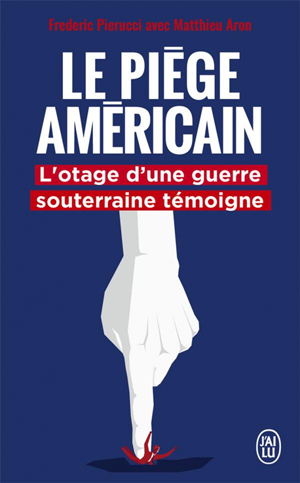
The Alstom experience will at least have had the effect of better preparing France for the moment when, a little later, the giant Airbus was targeted for malfeasance by the same American law. Airbus manufactures not only airplanes, but also many strategic military products protected by secrecy. This time, the widespread collection of the company’s confidential information was refused, without a French citizen being named as intermediary and the documents handed over to the Americans being reviewed to ensure that they did not contain military secrets or other information not directly related to the corruption charges.
Today, Airbus is a great success, selling more aircraft each month than Boeing, which is experiencing difficulties with the way it builds its aircraft. And we have every right to believe that senior management at Airbus has improved its business practices.
Title: Le piège américain — Les dessous de l’affaire Alstom (The American Trap, in the English version)
Authors: Matthieu Aron, Frédéric Pierucci
Drawing and color: Hervé Duphot
Publisher: Delcourt/Encrages © 2021
ISBN : 978-2-413-03738-5
13h17 dans la vie de Jonathan Lassiter
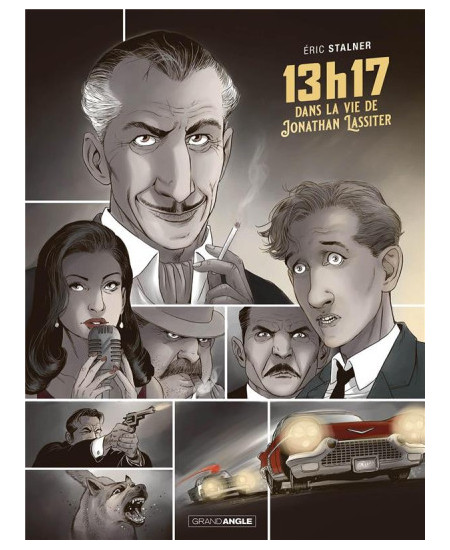
“When you’ve got nothing left to lose, you can take all the risks…”. This is the sentence [translated] on the back of the comic strip “13 h 17 dans la vie de Jonathan Lassiter” (13:17 in the life of Jonathan Lassiter), which best sums up this French-language work published in 2023.
Jonathan Lassiter works as an insurance agent in Keanway, a small, remote town in Nebraska. Overnight, his wife leaves him, he loses his job and his wallet is stolen. In short, his life suddenly takes an unexpected turn. He has two choices: either he feels sorry for himself, or he changes. His chance encounter with Edward, a “distinguished, cultured and cynical” man, forces him to take a stand.
It was the quality of the graphics that caught my eye. This isn’t one of those publications where you wonder whether the design can be done in a month, and which pretends to be original through the absence of detail, and therefore of work. A great deal of effort went into this album, and it shows at first glance.
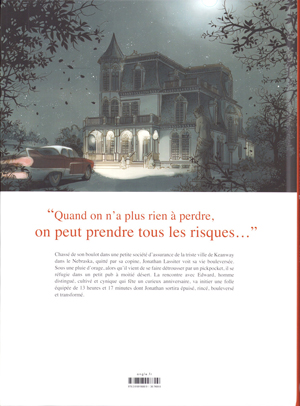
It’s got it all: the judicious choice of angles, the refined, masterful drawing, the skilful maintenance of atmosphere through well-dosed, under-saturated colors, the well-crafted script. This comic strip keeps the reader’s interest from start to finish, with no downtime.
The main character reminded me of the famous actor Vincent Price.
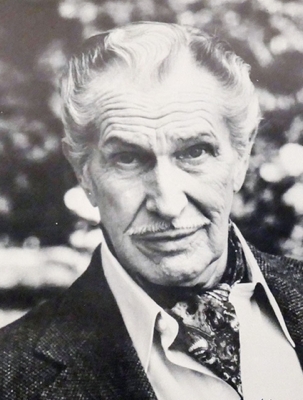
Title: 13 h 17 dans la vie de Jonathan Lassiter
Author : Éric Stalner
© 2023 Bamboo Edition
ISBN : 978-2-8189-9880-9
Un tournage en enfer – Au coeur d’Apocalypse Now
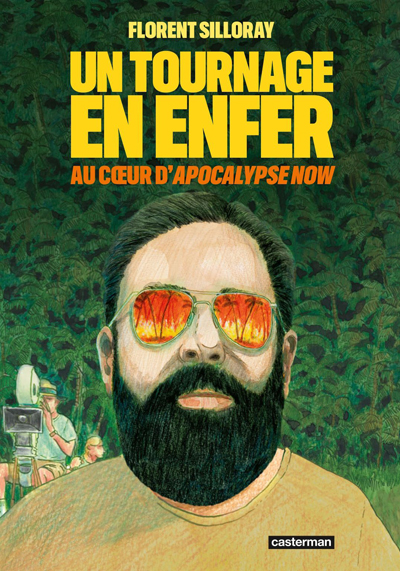
The graphic novel “Un tournage en enfer: au cœur d’Apocalypse Now” takes us right to the heart of the creation of Francis Ford Coppola‘s famous film, brought to the screen in 1979. As the director points out, [my translation] “[…] we were in the jungle. There were too many of us. We had access to too much money and too much material, and little by little, we all went crazy…”.
It didn’t start well. Right from the start, the director was unable to convince well-known actors to get involved in his film. In turn, actors such as Jack Nicholson, Al Pacino, Robert Redford and James Caan refused to join the adventure. Coppola continues his research and interviews.
As readers, we go behind the scenes of the production and hear from those close to the filmmaker. Filming begins in the jungle of the Philippines, even though Coppola has no idea on how the film will end. This would haunt him throughout the production, causing him sleepless nights when he was already quite exhausted.
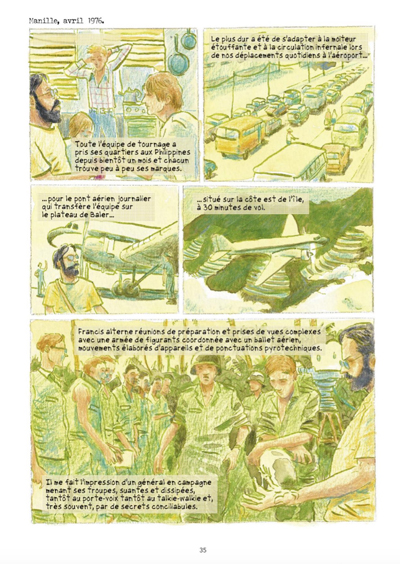
Cost overruns followed, and the pressure on the director from financial backers increased. He was asked to complete his film as quickly as possible, which he proved unable to do. Coppola came to guarantee the required funds by pledging to pay off the debt himself if box-office receipts failed to reach $40 million.
In addition, it was taken for granted that the U.S. government would provide the helicopter gunships required for the film’s action. But in the aftermath of the Vietnam War, the interest of American politicians in such requests waned. The director had to turn to the then President of the Philippines, Ferdinand Marcos, to obtain helicopters and personnel, in return for certain fees and compensation. But these aircraft sometimes left the scene on Marcos’s orders to go hunting for the regime’s enemies. Coppola was falling behind again…
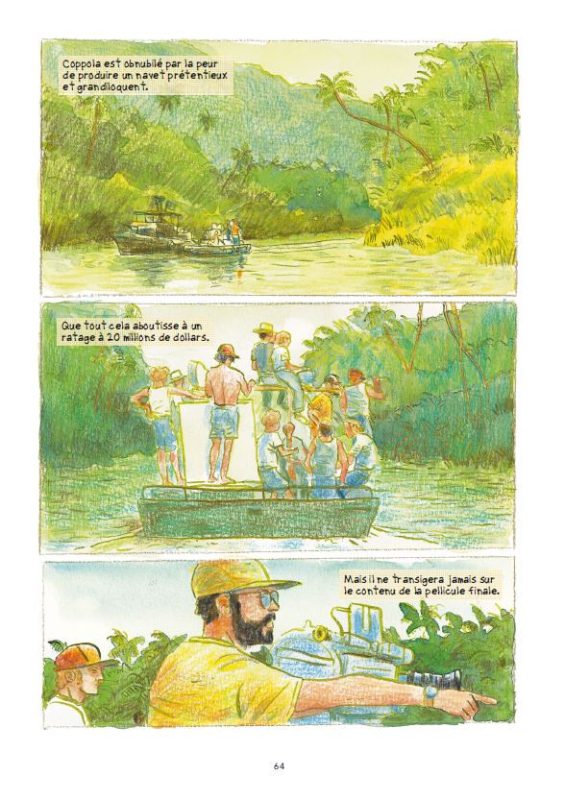
They thought that Harvey Keitel would be the ideal actor to play Robert Duvall. Many sequences later, the obvious becomes clear: the man just didn’t cut it for a number of reasons. On the verge of disaster, they urgently contacted Martin Sheen and beg him to replace Keitel. Multiple scenes had to be reshot with the new actor, and the delays and associated costs continued to mount.
All sorts of other pitfalls awaited the director and his crew throughout the shoot, including the language barrier with the Filipinos and a storm that destroyed the set. The widespread use of drugs and alcohol by staff and helicopter pilots didn’t help matters either.
The mosquitoes, the heat and Coppola’s constant demands took their toll on the actors. Martin Sheen fell seriously ill, and his brother had to be used for some of the secondary scenes. Rather than use only actors to simulate deaths, a staff member went to the morgue and returned with a corpse. This prompted the arrival of the police force, and the problem was solved with generous sums of money.
There were many other factors that delayed the end of the shoot and increased costs. Marlon Brando’s demands were a case in point. They managed to get him back on set for an extra day, provided that he received $70,000 more than planned.
Shooting finally ended in 1977. The team chartered a private plane to fly 381 kilometers of original film to the United States. Editing the film proved to be an ordeal. There was too much material to analyze. In 2001, Coppola presented a modified version of his original 1979 production. In 2019, he finally delivered a final 182-minute version, Apocalype Now “Final cut” , more than forty years after the initial release.
Earnings met the director’s expectations, and he ultimately won his bet. In all, the film generated $140 million from a total budget of $30 million.
Title: Un tournage en enfer – Au cœur d’Apocalypse Now
Author: Florent Silloray
Publisher: Casterman
© Casterman 2023
ISBN : 978-2-203-21653-2
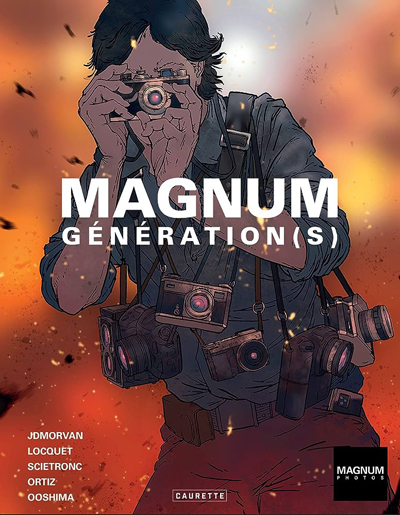
Through drawings and superb photographs, this graphic novel recounts the events that contributed to the creation of Magnum, the famous international photography agency.
Before Magnum, there were only photographers trying to make a name for themselves and earn a meagre living in the face of media giants like Time. These big companies reframed original images, did not recognize copyright and made gigantic profits on the backs of photographers like Robert Capa, David “Chim” Seymour, Gerda Taro, Henri Cartier-Bresson and George Rodger. It was in reaction to this abuse that these photographers created the new agency.
The book makes us aware of the enormous risks involved in bringing back images of the world’s various conflicts. Robert Capa and Gerda Taro lost their lives in the heat of the action.
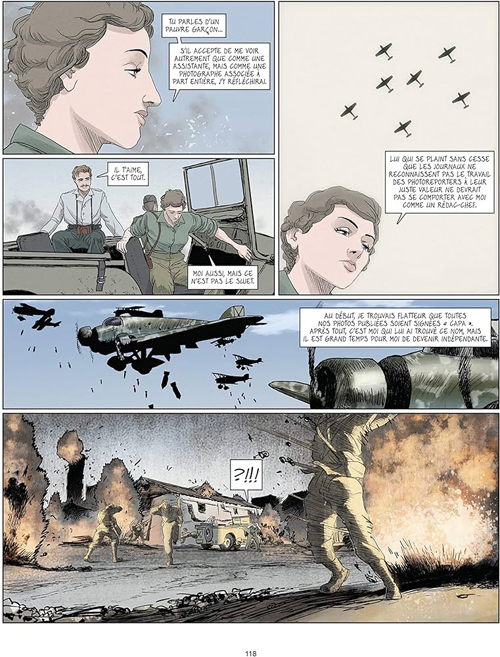
Magnum’s evolution, its internationalization and the change in its primary vocation are brought to life. From an initial focus on war coverage, photographers gradually turned to diversifying their activities, to accommodate the specific needs of both the media and film productions.
The agency now protects them from abuse. However, photographers remain mindful of the need of support from contractors to survive financially. Still, they reserve some leeway for pure creativity, depending on each photographer’s personality and the mood of the day.
Keeping this agency alive, made up of professionals with different ambitions, is no small task. There are crises, schisms and reinventions, all essential to the evolution of this internationally renowned institution.
For those who know nothing about Magnum, this graphic novel offers a very accessible first approach.
Title: Magnum Generation (s)
Scenario: JD Morvan
Drawings: Arnaud Locquet, Scietronc, Rafael Ortiz
Colours: Hiroyuki Ooshima
Edition: Caurette, ©2022
ISBN: 978-2-38289-028-8 (French version)
A graphic novel – Jours de sable
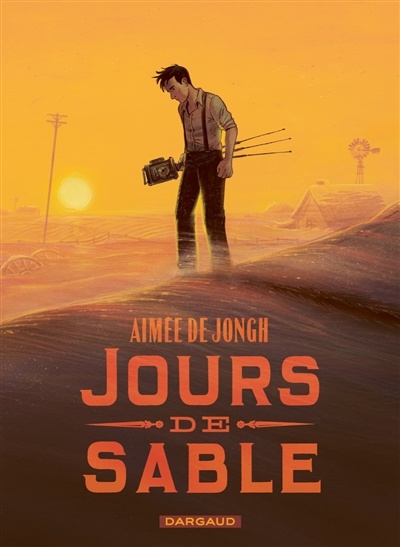
The graphic novel “Jours de sable” is a historical reminder of the famous Dust Bowl which struck the central United States between 1930 and 1940. These were ten years of misery that inspired John Steinbeck for his work “The Grapes of Wrath“.
The sand and dust storms that engulfed parts of Oklahoma, Kansas, Texas, New Mexico and Colorado came from a multitude of combined causes, including farmers’ overuse of the soil and repeated droughts.
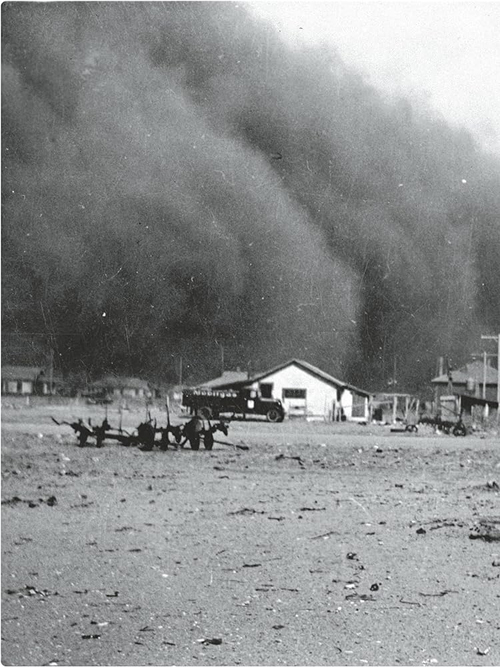
Add to these factors linked to the economic crisis and multiple epidemics, and we can understand the mass exodus of American households. They left everything behind, including many family members who died of dust-related respiratory complications. Most headed for the West Coast, but this massive influx of people only served to increase the region’s already high unemployment.
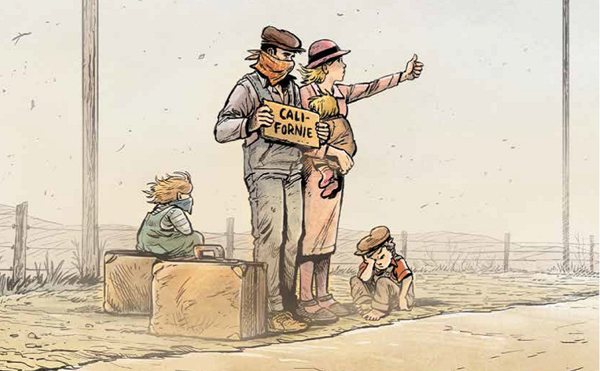
The strangest thing is that, decades later, the climate changes experienced today in these same states could help to repeat the phenomenon, without it necessarily covering such a long period.
Author Aimée de Jongh uses fictional characters, but the scenario respects the reality experienced by the population. In her story, a young photographer leaves New York in 1937 to report on the Dust Bowl. He has been briefed on the subjects to be covered, but soon realizes that he is dealing with a human tragedy of unsuspected proportions.
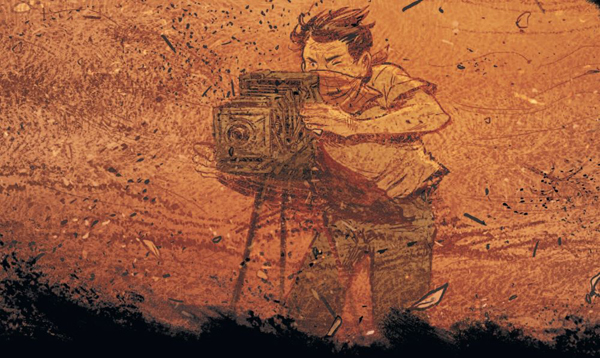
Asking suffering people who have lost everything to pose for the New York media was not as simple as he had thought. The situation becomes even more complicated when he gets to know these people and experiences their difficulties first-hand.
In addition to the deftly drawn panels that delight the reader, there are plenty of period photos gleaned from various museums, as well as official historical content. I loved this award-winning book.
Title : Jours de sable
Author : Aimée de Jongh
Edition: Dargaud, 2022
ISBN: 978-2-5050-8254-5
A graphic novel – Super canon
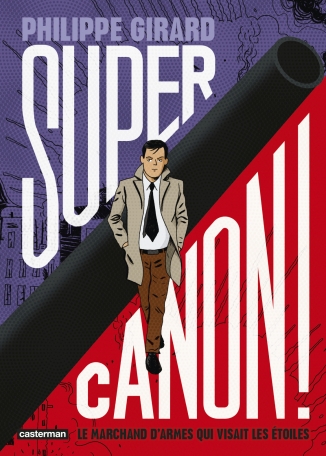
With “Super canon— Le marchand d’armes qui visait les étoiles”, writer Philippe Girard offers us a high quality graphic novel, as much for the scenario as for the drawings and colour choices. For this work, he benefited from an author residency in Liège. He certainly enjoyed his experience in Belgium much more than his writer’s residency in Poland, where he had to fend for himself because the hosts hadn’t respected the scheduled introductions and appointments. At the time, he used his misfortune to produce a very interesting graphic novel entitled “Le Starzec — un mois à Cracovie”.
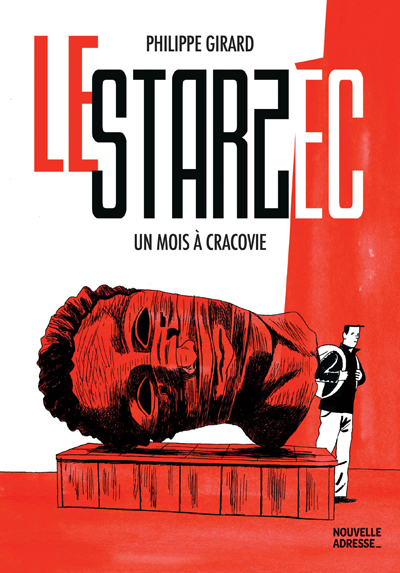
“Super Canon” is based on a true story, that of Canadian engineer Gerald Vincent Bull. Of course, it’s impossible to retrace this man’s life step by step, so the author has created a character named Doctor Gerry.
On reading the book, we realize the incredible talent of Gerald Bull, the scientist who revolutionized ballistics. We bear witness to his chequered destiny, tormented as he was between his youthful dreams and his boundless ambitions.
To balance his research budgets and keep his company afloat, he gradually transformed himself into an arms dealer. He offers his service to multiple states, including Canada, the United States, Israel, Iraq, Iran, China. In the process, he becomes the object of constant surveillance by many agencies and accumulates enemies.
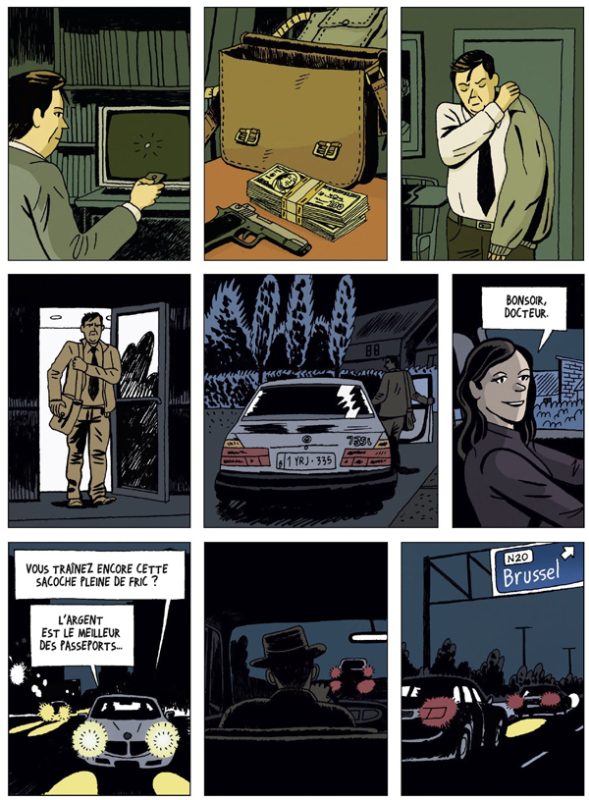
We’re dealing with a genius who has purposely blocked any critical thinking about his weapons of destruction. He dreams of a powerful cannon to send satellites into space, but the intelligence agencies of other countries hold very different plans for his invention.
He naively believes that he will be able to serve several masters with divergent interests, without this causing him the slightest problem. It borders on childish reasoning, on wilful blindness in the pursuit of the high life.
My only reservation regarding the content concerns the first page of the story. I find an ambiguity about Iraq and weapons of mass destruction (box 5, page 3). This was indeed the initial fear raised by the United States, but repeated follow-ups by UN inspectors had shown that Saddam Hussein had no such weapons. The invasion of Iraq couldn’t be justified on such a basis. The invasion went ahead anyway, and none of these supposed armaments were found in Iraq. I would have liked the UN’s conclusions to have been mentioned. This would have allowed to establish the book’s scenario on a basis that left no room for doubt.
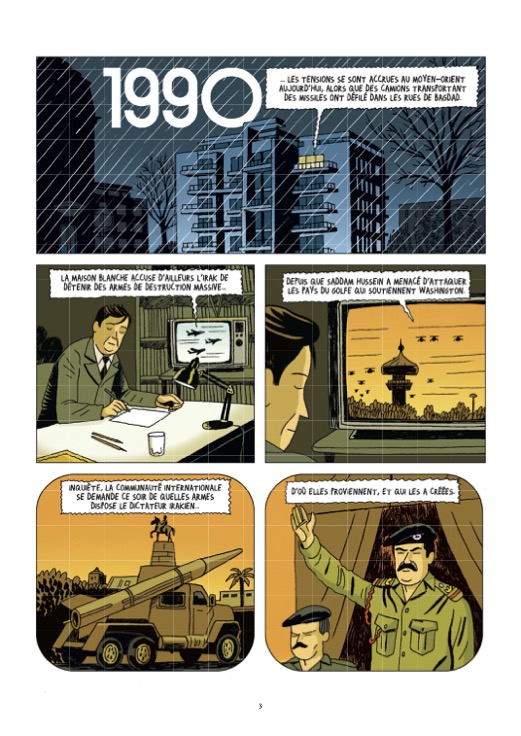
Otherwise, one thing’s for sure: you’ll enjoy this extremely well-crafted graphic novel.
Title: Super canon
Author: Philippe Girard
Publisher: Casterman, 2023
ISBN: 978-2-203-24112-1
A graphic novel – La disparition de Josef Mengele
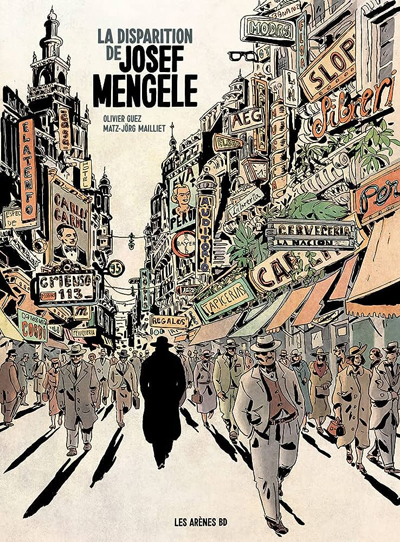
This new graphic novel is based on the non-fiction novel “The Disappearance of Josef Mengele” which was translated into 25 languages.
The graphic novel “La disparition de Josef Mengele” is a wonderful surprise for me, both in terms of the scenario and the graphics. Anyone interested in true stories will devour this book as it represents a goldmine of astonishing information on the life, or rather the survival, of the Nazi criminal in Latin America.
Who provides him with the money he needs? How does he protect himself? Does he lead the existence of a pasha? How does he behave abroad? Does his thinking on race show any sign of evolution, or is it still sclerotic? Why does Argentina encourage the arrival of these fugitive assassins?
For the general public, there are two categories of National Socialist criminals: the first concerns the names that received most media coverage at the Nuremberg Tribunal. The second involves Nazi criminals who fled abroad, thanks to political or family support. Josef Mengele belongs to both groups. He is holed up in Latin America and knows that several organizations are seriously looking for him, including Mossad.
How does he remain roaming for so long? It soon becomes clear that the Mossad is not only concentrating on Nazi criminals on the run. The book introduces us to some other priorities for the agency, one of which is very urgent: the elimination of former German scientists working in Egypt to create radioactive waste weapons designed to destroy Israel. The secret services must choose between Mengele, a past threat, or a more immediate danger. With limited resources, they have to adjust and deal with the most pressing situation.
Nazis were integrated into the new German government.
There is, however, a third category that the public has heard very little about, and which is also discussed in the graphic novel: these are Nazis who rejoined the new German government a few years after the end of the Second World War.
Indeed, the Allied powers of the time – the USA, Great Britain, France and the Soviet Union – administered the occupation zones of the German territory after the Second World War. But tensions between East and West grew rapidly. Each side accused the other of imperialist or communist expansionism.
To offer a better-organized resistance to the Soviet Union, Germany’s autonomy had to be quickly restored. The former Nazis had experience of governance that was immediately available.
If the Allies adopted the clear-cut position of preventing the Nazis from attaining essential functions in the public apparatus of the future Bonn Republic, then people with little or no knowledge had to be trained to carry out the more complex tasks. Time was short, as was the will to bring all possible war criminals to justice.
So, many Nazis found work in government agencies. One thing led to another, and some of these former Nazis recycled as government agents became part of the inner circle protecting the most prominent war criminals who had fled abroad. Josef Mengele benefited from this high-level support.
But several additional Germans, also in high places, acted in the opposite direction, striving to flush out the biggest criminals, at the risk of their own health and safety. One such person is introduced in the book: Fritz Bauer. This man contacted Mossad with information that eventually help to capture Adolf Eichmann. The latter went on trial in Israel and sentenced to hanging.
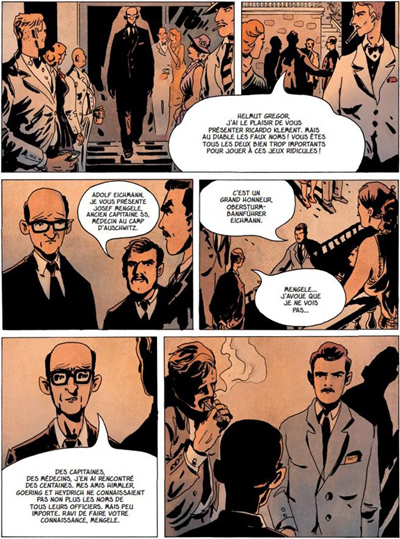
Mengele reads the newspapers and suspects that his end will resemble that of Eichmann. The graphic novel shows him as a hunted animal, talking to himself. His racist, backward-looking words drive away the individuals who could support him most in the last years of his life. He withered slowly and died on a beach in Brazil. But it was not officially known until 1985.
The book covers a period of several decades. It features a brief summary of Mengele’s actions as a doctor at Auschwitz. He is not alone, even if he remains very high-profile to the general public. A large number of scientific assistants carried out experiments on humans, including one who became rector of the University of Münster after the end of the Second World War.
The authors mention in passing the idea of a Fourth Reich pursued by Mengele and his ilk. In short, readers won’t get bored with this skilfully constructed graphic novel.
Title: La disparition de Josef Mengele
Authors: Olivier Guez and Matz-Jörg Mailliet
Edition : Les Arènes, Paris, 2022
ISBN : 979-10-375-0714-3
MBS – L’enfant terrible d’Arabie Saoudite
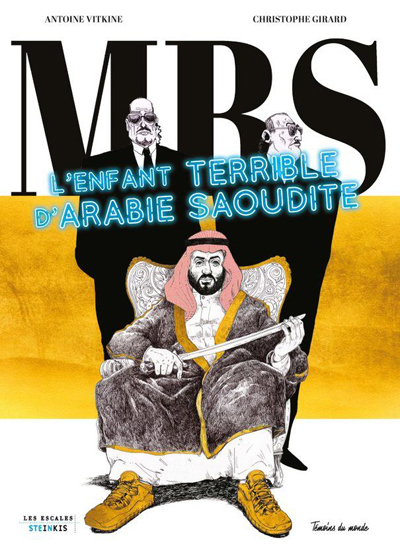
When they hear the name Mohammed Ben Salmane (MBS), most people don’t react, as they can’t associate him with anything. If they are told that it was he who had a journalist cut up into small pieces and stuffed into garbage bags in the Saudi Arabian embassy in Turkey, it resonates more.
The graphic novel “MBS— L’enfant terrible d’Arabie Saoudite” introduces us to the life of this implacable ruler who tries to forge links with the great powers. By negotiating his support with the United States, Russia, China, India, or France, he seeks to position his country as a major player on the world stage.
The book is also a very interesting first approach to the history of Saudi Arabia, especially with regards to the Saud family and its reign. We realize the importance of alliances and radical decisions by MBS if he wishes to attain supreme power and hold to it.

Domestic and regional stability remains a top priority for MBS. Even if he wants to modernize society and appeal to young individuals, he must at the same time avoid upsetting the Wahhabi clerics too much. The latter enjoy ancestral prestige and have a marked influence on the way people behave and think.
When it comes to imposing his ideas, MBS hasn’t invented a thing. Like most rulers of the world’s major countries, he has learned to use the media and spares no expense to achieve the desired results.
Top managers of intelligence and news organizations know very well the limits within which they can operate. You won’t see any photos of MBS spouses, or articles that would enlighten the public about the nightlife of the leader and his friends.
This graphic novel maintains interest by interspersing surprising anecdotes with pertinent information accessible to all. As the back cover of the book states, “This ambitious prince happens to be our ally in the Middle East: oil, the fight against terrorism, Arab-Israeli peace, arms sales … we need him. But what price will we pay?”
Title: MBS— L’enfant terrible d’Arabie Saoudite
Authors: Antoine Vitkine and Christophe Girard
Publisher: Steinkis/Les Escales
© 2023
ISBN: 978-2-365696-88-3
Warbirds: B-25 Mitchell – Tonnerre sur Tokyo
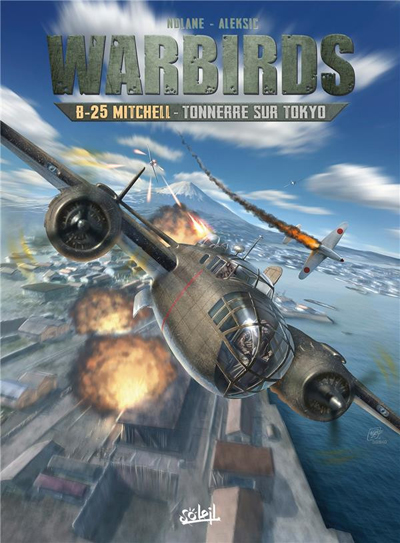
This comic book, published in 2023, is the third in the Warbirds series, published by Editions Soleil.
On April 18, 1942, a few months after the Pearl Harbor raid, sixteen B-25B Mitchell bombers took off from the new Hornet aircraft carrier for a surprise attack on five Japanese cities. The mission was known as the “Doolittle Raid“.
These machines, which were not designed to operate from an aircraft carrier, would not be able to reach their targets and return safely to port for lack of sufficient fuel. All the pilots were well aware of this, and volunteered.
The fleet of sixteen aircraft, commanded by Jimmy Doolittle, successfully achieved its objective of confusing the enemy and showing that Japan remained vulnerable to surprise attacks. The Japanese wondered how it was possible that American bombers could have reached and hit their country. Where did they take off from? They know that the B-25 Mitchells were not designed to take off from an aircraft carrier, and that they were incapable of landing on one.
The genius of the operation laid in the combination of a number of highly risky decisions which, taken together, took the enemy by surprise. Firstly, as it was impossible to land the planes on the Hornet, they were installed with a crane, knowing full well that they would never return to the ship.
In addition, the captains were trained to take off over distances unthinkable for them, using a technique pushed to the extreme. The ship sailed at high speed into the wind, improving the headwind component so essential for such perilous maneuvers.
The pilots had to be extremely skilful to keep to the departure trajectory on a platform that moved from left to right in the middle of a storm. Buildings on the Hornet’s side had to be avoided at all costs, and the available gap between the wing tip and the ship’s tower was no more than two meters. Despite all the obstacles, all the B-25s managed to take off. It was to be a one-way mission to Japan.
Doolittle piloted the first B-25 to take off from the carrier. He had only a very small portion of the deck to work with, as there were still fifteen other bombers waiting their turn to take off. The second pilot to leave the deck narrowly avoided a water landing, as the aircraft sank slightly and a landing gear wheel touched the water. But the plane gained just enough speed to stay airborne.
Bombers and crews suffered different fates once the bombing raids on Japanese targets had been completed. The authors conclude: “The raid destroyed 112 buildings and killed 87 people, in about 6 minutes. […] The destruction of 15 of the 16 B-25s, unable to reach Chinese airfields for landing, was nevertheless to be deplored, the 16th B-25 having landed safely in the USSR. Also to be deplored was the accidental death of three airmen (planes 3 and 6) and the capture of 8 others (planes 6 and 16) by the Japanese, 4 of whom never returned home, 3 having been executed as “war criminals” and the 4th having died in captivity. Worse still, the Japanese took revenge on the Chinese, who had helped all the surviving airmen, by organizing the massacre of some 250,000 civilians in the Zhejiang and Jiangxi provinces then under their control. This was to leave its mark…”.
Landing and takeoff tests on an aircraft carrier, the Forrestal, were also made decades later for a C-130 Hercules. I tried to repeat the experience in flight simulation. The flight can be found in the “challenging virtual flights” section of my blog. As the Forrestal is not available in virtual mode, I used the aircraft carrier USS Enterprise.
Title: Warbirds: B-25 Mitchell: Tonnerre sur Tokyo
Authors: Richard D. Nolane and Vladimir Aleksic
Edition : Soleil/D. Nolane/Aleksic
ISBN : 978-2-302-09745-2
© 2023
Accidental Czar
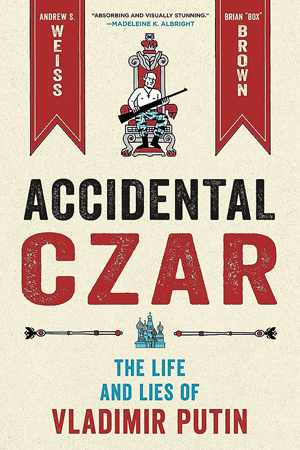
Note: The excerpts are taken from the French version of “Tsar par accident” and re-translated into English using DeepL.
Author Andrew S. Weiss has worked at the White House, the Pentagon, the State Department, and so on. He points out: “If someone had told me at the time that a former KGB non-commissioned officer – who had never really shone – a certain Vladimir Putin […] – would be promoted from the back rooms of the Kremlin directly to the head of the country, I would have told you to get yourself treated”. He adds: “What we think we know about him is often a clever mix of counter psychology and misinterpretations of Russia‘s thousand-year-old history “. His staging as a tough guy “allows him to come across as more intelligent – and more competent – than he really is. […] “.
The graphic novel “Accident Czar” tells the story of how Vladimir Putin found himself in power at a time when his rather lacklustre career was destined for a lesser position. But the same could be said of some of the world’s dictators, presidents, kings and ministers over the ages who have been blessed with good fortune. They too have taken advantage of favorable opportunities to climb the ladder too high for their natural talent. The nation then pays the price until the person’s overthrow, exile or death.
Still, we have to give Putin credit for persisting, for hanging on, despite setbacks and rejections. To join the KGB, he was told to study or join the army. He did so and received his diploma.
In 1975, he joined the KGB. But it wasn’t the big missions he had dreamed of that awaited him, but local fieldwork. He failed to impress his superiors with the results he achieved. Following a brawl in the subway, he was transferred to Dresden in 1985, where his missions were meaningless due to lack of budget. In 1999, President Clinton was told that Putin would be the next Russian president. What had happened between 1985 and 1999 for Putin to suddenly emerge from obscurity and become President of Russia?
Credit must be given to his work ethic, but above all to his loyalty to his bosses in an organization that favors personal ties. Yeltsin, the president at the time, sensed his end was coming and offered Putin a deal. The author writes: “He would make him president if he agreed to protect him and his family“.
Just as Hindenburg believed he could manipulate Hitler by giving him access to the highest echelons of government, so Yeltsin thought he could do the same with Putin. In both cases, it was a costly mistake for Europe and the world.
The book reviews the rise of the Russian oligarchs, and the rapprochement of power for Putin’s friends. Andrew Weiss points out: “One of the points that foreigners don’t always grasp is that Russia is a society that operates on the basis of personal ties, rather than within the framework of institutions or the rule of law.“
In the years following the fall of the Berlin Wall, important sectors of the Russian economy were taken over by corrupt officials and KGB agents, as well as by the mafia. As the author writes: “Vladimir Kumarin, all-powerful boss of the notorious Tambov gang, ruled the country“.
Vladimir Putin’s support for the United States after the attacks of September 11, 2001 brought him closer to George W. Bush and his father George H. W. Bush, with whom he even went fishing in Kennebunkport. He hoped to revive the moribund Russian economy and gain the freedom to control the Russian media.
What’s most astonishing to me is that, during this period, Putin approved the highly controversial establishment of American and NATO bases across the former Soviet Union (Uzbekistan,Tajikistan, Kyrgyzstan ). With this gesture, he was seeking stabilization with the West. With the causes of the September 11th 2001 attacks still being debated around the world today, especially in the most informed circles, Putin was later forced to reflect on the relevance and consequences of his decision to authorize new American and NATO bases near Russia.
The Russian president quickly realizes that he doesn’t carry much weight in the diplomatic balance against a superpower like the United States. He is not recognized as a player to be reckoned with. With a view to better understanding between the West and Russia, the author stresses the importance of better understanding the grievances of both sides. He points out that this is sorely lacking.
Especially since the Kremlin is convinced that “demands for political change are always the result of Western-backed conspiracies“. All the major nations, by dint of monitoring each other and trying to influence the internal management of other countries, are projecting their intentions and no longer believe that a protest can come from the bottom up, based on a serious desire to improve certain detestable policies.
The author takes a look back at the problems surrounding Russia’s territorial security through the ages, invaded in turn by the Mongols, Napoleon and Hitler: “[Russia] traditionally relies on annexed territories to act as a buffer between the motherland and any external threat“. He also discusses the Chechen conflict, the fight against terrorism, political interference in neighboring states and Russian involvement in the 2016 US elections.
Andrew S. Weiss covers a lot of ground, and other themes find their way into the book: the history of the Cold War, Trump, Snowden, Wikileaks, the Sochi Olympics and the work of Maria Butina, a Russian agent who managed to penetrate the upper circles of the American Republican Party.
It was his belief in the irreversible decline of the West that enabled Vladimir Putin to invade Ukraine.
The author concludes with a remark on the invasion of that country and the indiscriminate bombing of civilian targets: “The world is beginning to understand that Putin was never the strategist he claimed to be. He is an improviser caught in his own trap”.
Allow me to make a comment about the invasion of Ukraine. This country is to receive fighter planes from the Allied States to protect its territory, which deeply offends Russia. However, I would like to remind you that during the Second World War, the Soviet Union accepted a great deal of outside help for its defense on the Eastern Front. To name just one aircraft and country, the Soviet Union obtained 877 B-25 Mitchell bombers from the USA.
Title: Accidental Czar: The life and lies of Vladimir Putin.
Author: Andrew S. Weiss. Illustrator: Brian « Box » Brown
Edition: Macmillan Publishers
ISBN: 9781250760753
© 2022
Le passager du Polarlys
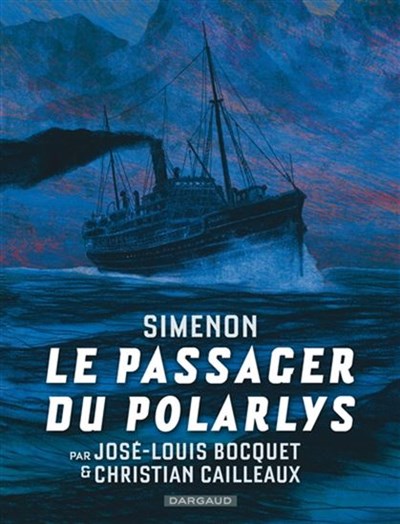
The Dargaud publishing house has come up with the excellent idea of choosing some of Georges Simenon’s novels (excluding those in which Inspector Maigret takes centre stage), and converting them into comic books. They intend to use two scriptwriters in turn, as well as different illustrators, for each of the eight publications planned over the next few years.
The first of these publications is entitled “Le passager du Polarlys”. I wasn’t sure when I saw this new title in bookstores, but the name of Georges Simenon on the album convinced me to give it a try. And what a great reading experience it was. Everything is there: an interesting plot, very well-executed drawings, endearing characters and, above all, the sea with all its challenges, especially at the time when the novel was written.
We sail along the Norwegian coast, with its small villages and perilous access in heavy weather for a summarily equipped ship. The colours chosen also lend themselves well to the drama unfolding on the boat. In short, you finish reading and immediately want to pick up the story again. You won’t be disappointed.
Title: Le passager du Polarlys
Authors: José-Louis Bocquet and Christian Cailleaux, based on the work of Georges Simenon © 1932
Edition: Dargaud Benelux (Dargaud-Lombard s. a.)
© 2023 ISBN: 978-2-5051-1223-5
Une saison à l’ONU.
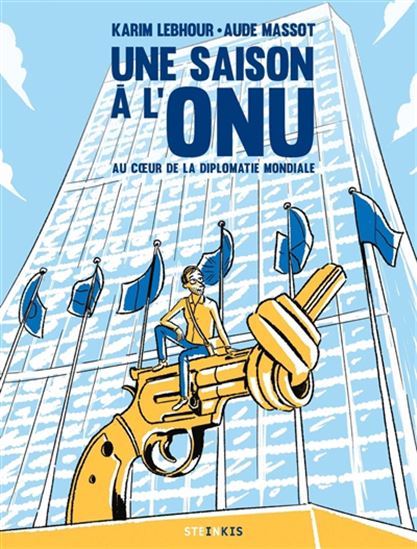
The graphic novel “Une saison à l’ONU” (A season at the UN) makes it easy to understand the various challenges facing the UN, this necessary organization, but one that is largely hampered in its interventions.
International crises and the complexity of day-to-day political maneuvering are not lost on the author, who nevertheless chooses to adopt a light-hearted tone to keep the reader’s interest throughout the book. Funny stories, humor and confidences alternate to bring the story to life.
We all know how difficult it is for the UN to pass resolutions. There is pressure from all sides and the use of veto powers. As a North American, I hear more about the use of the veto by Russia or China than by the United States. The author puts a figure on the use of veto by all the major powers and the result is surprising.
The reader gains a better understanding of the grammatical mastery and compromises required to ensure that a note from the UN receives international approval. You have to know how to dilute and spare sensitivities if you want to be able to publish without generating too much opposition.
In short, “Une saison à l’ONU” is a graphic novel full of interesting and relevant real-life stories. The book demystifies some of the UN’s activities in New York as well as abroad.
Title: A Season at the UN
Author: Karim Lebhour and Aude Massot
Publisher: Steinkis
© 2022
ISBN: 978-2-36846-610-3
Environnement toxique (Ducks).
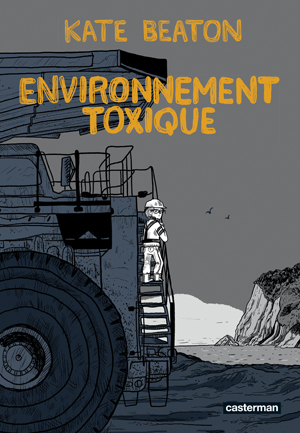
To pay off her student debts quickly, Kate Beaton, a young Nova Scotia resident, decided in 2005 to go and work in northern Alberta for oil companies exploiting the tar sands. At the time, this trip west was popular with Canadians looking for a lucrative job. So she left the paradisiacal landscapes of Cape Breton to plunge into the world of Syncrude and Shell in Fort McMurray.
It was then that she realized what life was like on construction sites occupied mostly by men far from their families, many of whom had behavioral problems. Wherever she found herself, she suffered harassment in the form of derogatory remarks, insults, and eventually sexual assaults.
For these workers, loneliness and survival take on a completely different meaning than for the rest of the male employees in these isolated posts.
A multi-talented storyteller and cartoonist, Kate Beaton published a graphic novel in 2023 describing her experiences. She denounces “a harsh and complex system, which exploits natural resources as coldly as it does human beings”.
“Toxic Environment” is less about the destruction of habitat caused by tar sands mining than about the toxic working environment endured by the few women working on these sites.
Time Magazine, The Guardian and The New Yorker hailed this graphic novel, which also happened to be the winner of the Canada Reads 2023 contest. It was published in English under the title “Ducks“, probably to remember all those ducks caught in the oil that made headlines at the time.
Happy reading!
Title: Environnement toxique (Ducks in English)
Author: Kate Beaton
Publisher: Casterman, for the French version
ISBN: 978-2-203-24223-4 (French version)
©2023
Scale drawing of “The Valley of the Immortals, step 1”.
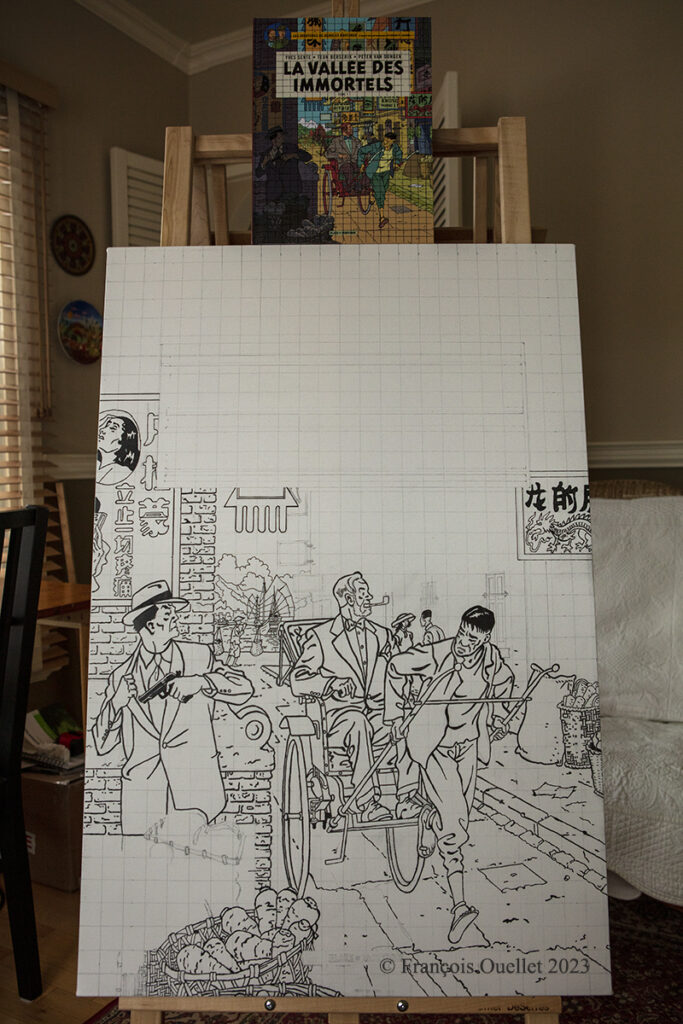
In February 2023, I began transferring the cover of the Blake and Mortimer album “The Valley of the Immortals – Part 1“ to a 24 x 36 inch canvas.
The photo above shows the original album sitting on top of the canvas and the work in progress. There is still a lot of work to do before the drawing and lettering are finished.
Then comes the coloring stage, to get the tones as close as possible to the original album. The cover has a lot of colors, which is not the case with many other Blake and Mortimer albums.
This particular album resonates with me for several reasons. First of all, the authors use in the scenario a Cessna C-170B type plane, which brings back memories of flying. Indeed, by a happy coincidence, in 1981 I flew across Canada in this small aircraft dating from 1952. The plane was not equipped with any air navigation instruments, except for an old compass. We were not yet in the GPS era! I published the story of this flight from St-Jean to Edmonton on my blog.
Another reason that increases my interest in the album is also related to a memory. On the cover, Mortimer is in Wan Chai District, a district I visited in 1990 during a trip to Hong Kong and the New Territories. At that time, the Cathay Pacific Boeing B-747 used the legendary Kai Tak airport and flew the approach over a huge demonstration of more than 100,000 people commemorating the anniversary of the Tiananmen Square massacre.
I will be posting more photos of “The valley of the immortals” painting over the next few months, numbering the title of each article so that those interested in the subject can find their way around.
Scale drawing of “The Valley of the Immortals, step 2”.
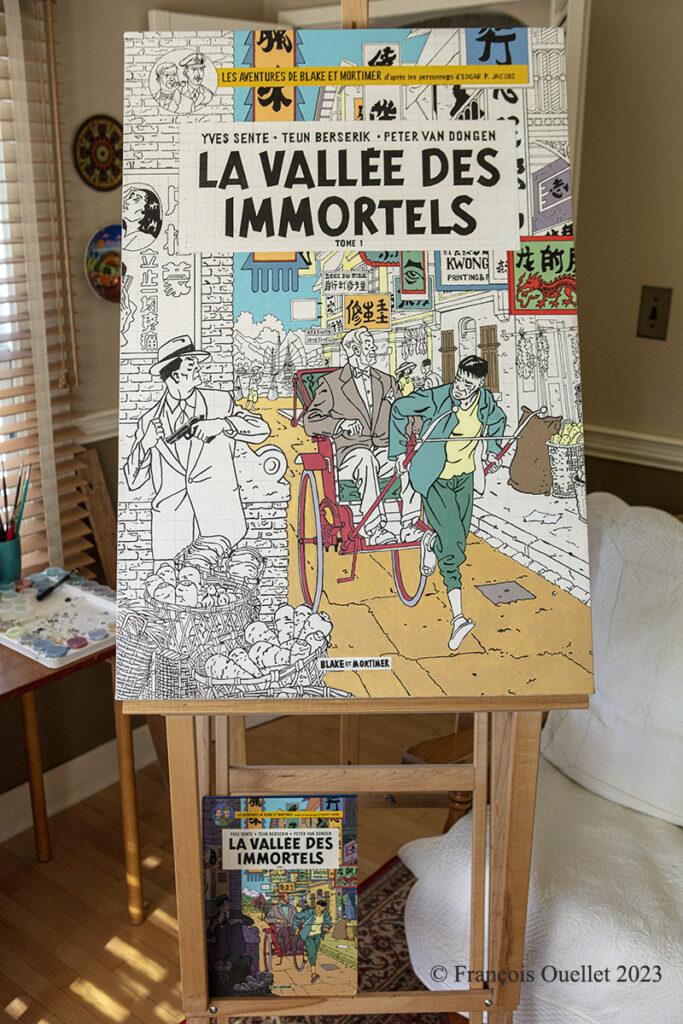
This is step 2 of the enlargement work I started from the Blake and Mortimer comic book: The Valley of the Immortals. The original album is at the bottom of the image above to give an idea of the original scale.
I want to use the entire 24 × 36 canvas space starting from a standard size comic book. I must modify the scale by adding an extra 10% to the height. However, when comes the time to draw the perfect circle located at the top left of the album, a standard 1:1 scale must be used so as not to transform the faces of the two heroes who are looking at us from the front. A painting made with two different scales does not produce a true copy, but it is still acceptable and realistic.
Trying to match an album’s original colour often requires mixing four different colours or more. Experience has shown that any newly created colour should be allowed to dry for several minutes on another canvas to ensure that it does not deviate too much from the desired colour, because it darkens when it dries. Mistakes are inevitable, however…
It looks as I will complete the canvas within the next few months, providing I work a few hours each day.
Scale drawing of “The Valley of the Immortals, step 3”.
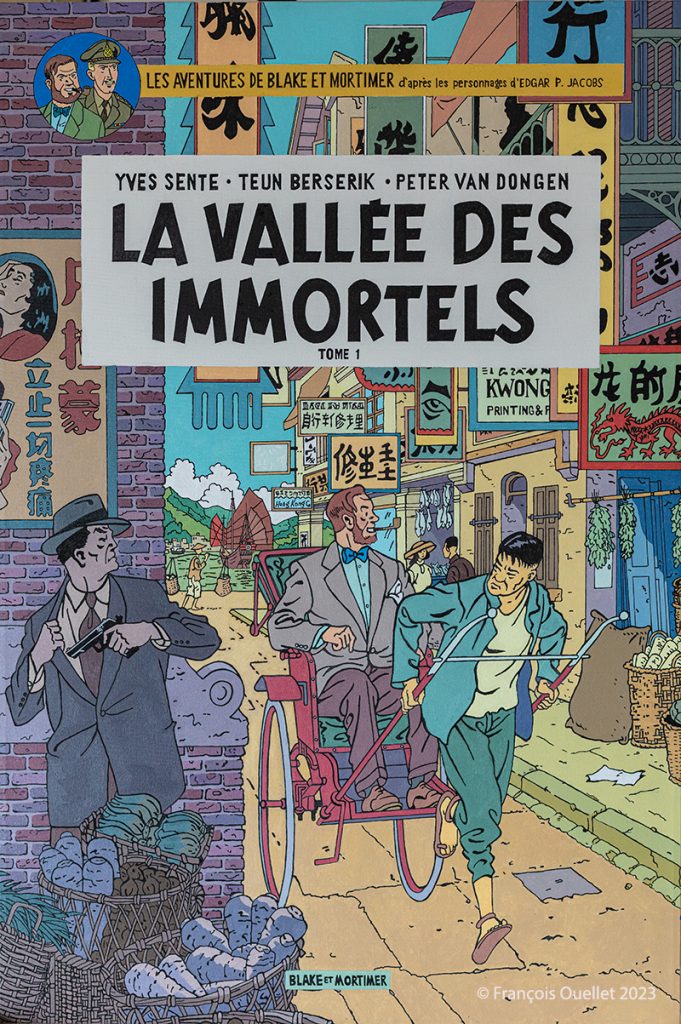
I finally completed the final stage of the 24″ x 36″ canvas of Blake and Mortimer , “The Valley of the Immortals, Volume 1”. I had hoped to finish the whole thing before the summer, but other more pressing obligations disrupted the planned schedule.
The whole project will have taken around 200 hours and required the creation of some 130 colors in an attempt to imitate the album, at least in part.
I deliberately lightened the original work, especially the left-hand side, as I hang the painting on a wall and found the scene far too dark. My version respects the idea of chiaroscuro while adding a little light. Painting the canvas yourself also lets you play with the different shades of the bricks on the left-hand wall.
Eight Hours in Berlin.
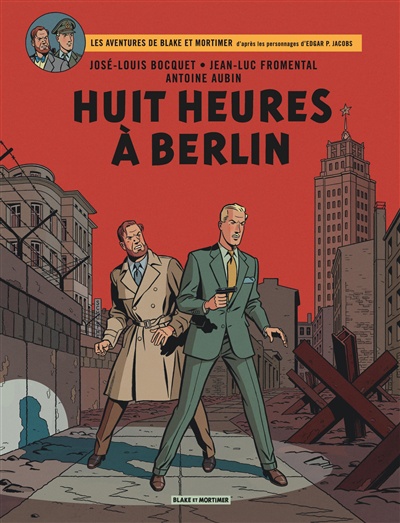
This new album of Blake and Mortimer adventures has received excellent comments from the faithful readers. It is the first time that José-Louis Bocquet, Jean-Luc Fromental and Antoine Aubin work together and they make a great team.
For several years, the combinations of authors and artists have followed one another to ensure a constant rhythm of publication, that is to say, one comic book of Blake and Mortimer per year.
For Dargaud-Lombard, this is a significant source of revenue, as the series has had a worldwide following for several decades.
“Eight Hours in Berlin” plunges us into the Cold War, at the time the Berlin Wall was just built. Older readers will be familiar with the events surrounding the construction of the wall, but for younger readers it will generally be a first but accessible approach to this period.
Everything is well thought through in this album: there are notions of history and politics, period reconstructions of the exterior architecture, beautifully designed furniture, superb vehicles and the colors are judiciously chosen by Laurence Croix.
The scenario brings us between Germany and the former communist bloc countries. As we progress in the story, we walk through a tunnel created at the time by the West to listen to the conversations taking place in East Berlin, we enter an old asylum supposedly abandoned long ago, etc. Moreover, as always in this comic book, the mixture between reality and science fiction adds to the interest.
The authors try to rejuvenate the old Mortimer a little without losing the fans along the way. The women get a positive or a negative role but they are no longer handbags holding potiches. It’s hard to imagine that we would have ever seen a nude on a garage calendar in an album of this series. What a scandal! It wouldn’t have been accepted at the time Edgar P. Jacobs wrote his first album, after having worked with Hergé for the Tintin albums…
In short, this twenty-ninth album of the series is a great success. It is obvious that this trio of creators will be entrusted with other albums.
Scale drawing of “Tintin and the black island”.
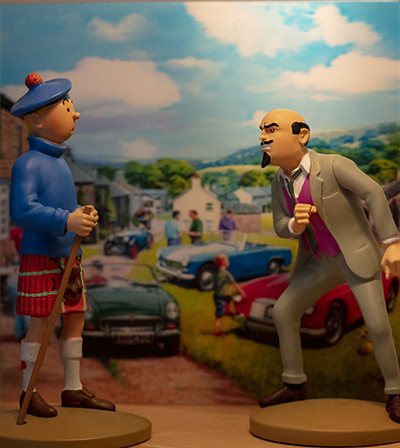
In the photo above, you may have recognized Tintin dressed as a Scotsman as he faces the evil Dr. Müller. These two characters are from the comic book Tintin and the Black Island. A majority of French speakers probably read this album in their youth. And, even as adults, some of us (myself included) have revisited this work by Hergé to get a fresher look at the album.
The restrictions and confinement of the Covid-19 pandemic allowed me to devote more time to drawing and painting. I decided to copy the cover of the Tintin album “The Black Island” using acrylic.
The scale drawing of a Tintin album is close to a 2:3 ratio and so the 24″ by 36″ format was almost a perfect fit. Below, you can compare the difference in scale between the original book and the drawing in the making.
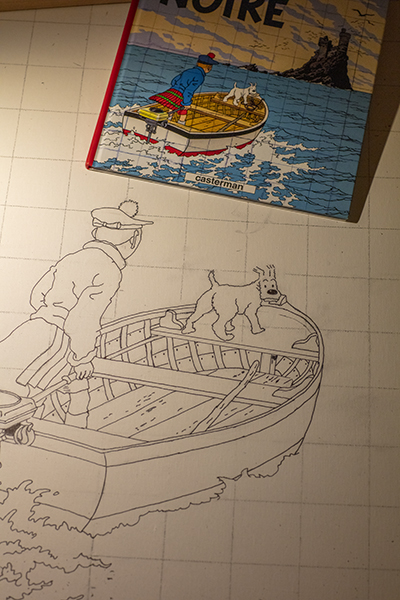
A 2H graphite pencil for drawing on canvas will require less dedication when it comes to erasing the most obvious strokes and laying down the paint. The one I used (HB) was too dark and required more work than expected.
Reproducing a Tintin album leads us to progressively notice the genius of Hergé, this Belgian creator. We linger on his editorial choices, the composition, the angles. Drawing the rocks of the Black Island and their shadows is, in this respect, very revealing.
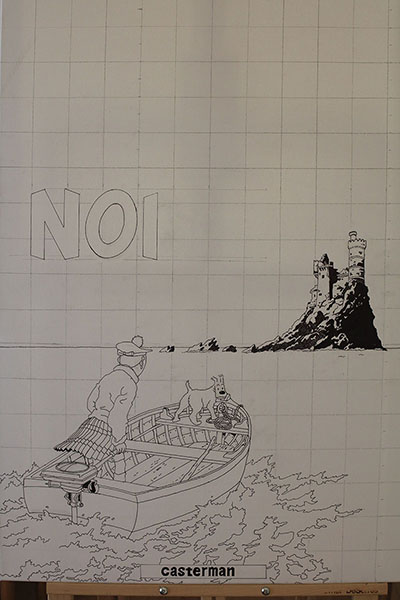
In the photo above, Tintin is heading towards the Black Island. We can feel him anxious, hence his slightly forward-leaning posture. He scans the island straight ahead. Hergé could have drawn him straight on his boat, confident. He chose to position him as an observer of a problematic situation. Similarly, Snowy looks at us with a worried expression and we have to repeat his expression exactly so as not to change the atmosphere of the scene.
Still missing are the black birds around the island, one of which seems to be heading straight for Tintin. You will see them in the next article: they are numerous, black and do not seem very friendly.
The sky, meanwhile, is not covered with pretty cumulus clouds but rather with streaky, tapered clouds invading the horizon, many of them dagger-like. Placed obliquely across the cover for added dynamism, Hergé also gave them a slightly circular shape.
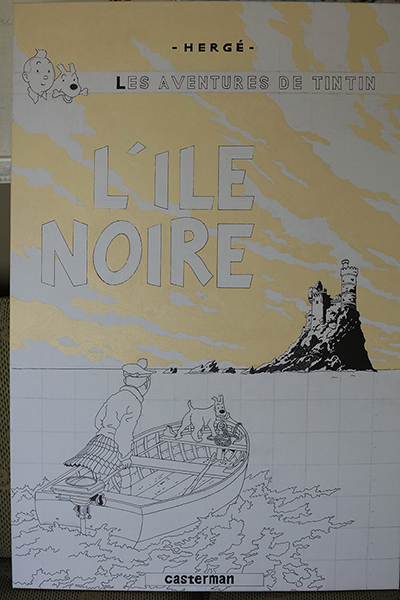
When painting the letters, one realizes the editorial choices of Hergé. Several of these features require attention, including the letter “O” which is not round but oval and leaning to the side. Also, Hergé aligns the two words of the title to the right and this has an impact when calculating the spaces between the letters.
In trying to reproduce a color exactly, one must make several attempts to discover the recipe. Often, three or four colors are combined to achieve a satisfactory result. And when we are satisfied with the tone, a surprise awaits us: once placed on the canvas, the acrylic paint changes color and becomes much darker as it dries. Trying to predict the result after drying is therefore a must.
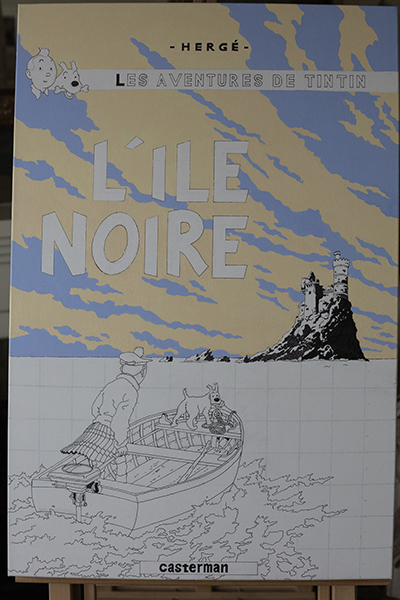
The photo above shows the clouds almost completed. The yellow sky was a problem, because once on the canvas, the color became too dark as it dried. I had to find a recipe for a lighter yellow than the one on the original cover so that as it dried the color would get darker and match the color of the album.
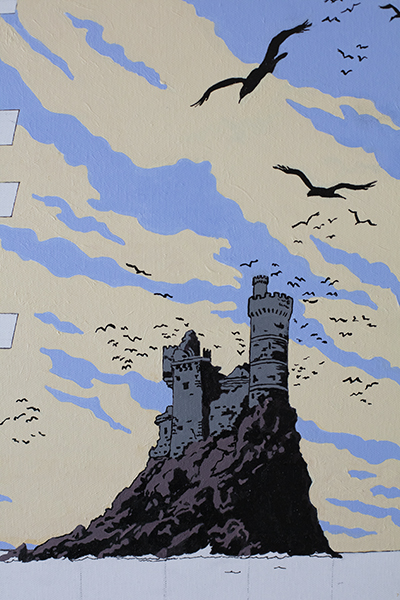
The photo above shows the progression of the castle and the island, but this time with the birds as a bonus. Hergé drew a lot of black birds around the castle, which adds to the sinister look of the place. But he also thought of drawing two larger birds in the foreground, of which one seems to be heading towards Tintin.
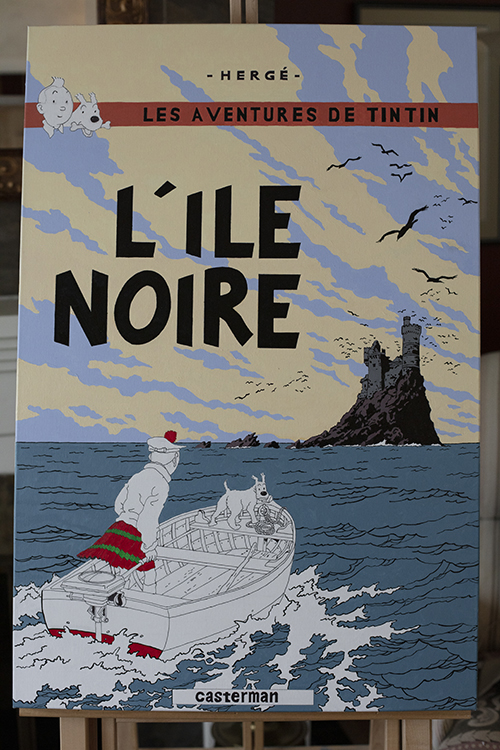
The painting is progressing rapidly. I have already worked on it for about a hundred hours to get to this point. The sea has received all its touches of black paint to form the appearance of waves.
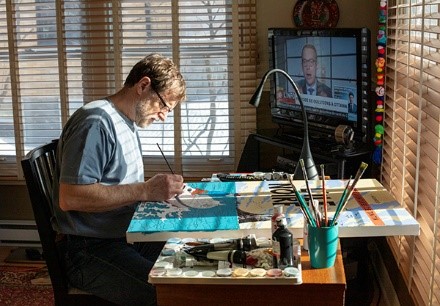
The picture above gives an idea of the size of the painting. The painting must often be placed on a table to paint the elements that require great precision.
In the background of the photo, a journalist from the Canadian news channel RDI is seen on television. He is commenting on the street blockage situation in Ottawa by truckers during the Covid-19 pandemic. The protesters fight for their rights, but do not respect the rights of the citizens of Ottawa who, for weeks, are trapped in their neighborhoods. The Canadian government finally put an end to the situation by invoking the Emergency Measures Act with the added bonus of a $306 million lawsuit brought by residents against the protesters.
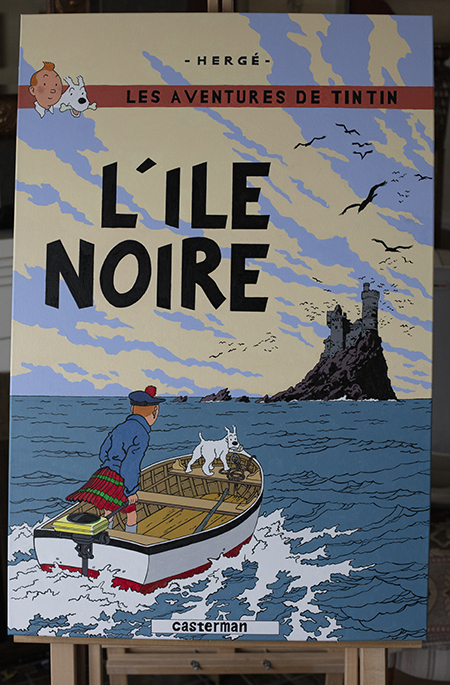
Above is the completed painting. You will notice that the white tones of the boat differ on the back and side. There is white combined with black and a touch of yellow for the side of the boat, rather than the pure white required for the back. It took some experimenting with colors to finally realize the need for yellow.
The waves flattened by the boat are now just rounded bubbles behind the boat. However, on the sides, the appearance differs because the movement of the boat breaks the waves: Hergé therefore ensures a different treatment of the foam. He thought of everything, as usual!
It is now time to move on to another project. I am not sure yet, but I am thinking of “Blake and Mortimer” these heroes of Edgar P. Jacobs, a great master of the clear line style who initially worked with Hergé.
Glénat just published a book titled “Edgar P. Jacobs le rêveur d’apocalypses”, if you want to learn more on the subject…
Mégantic – Un train dans la nuit
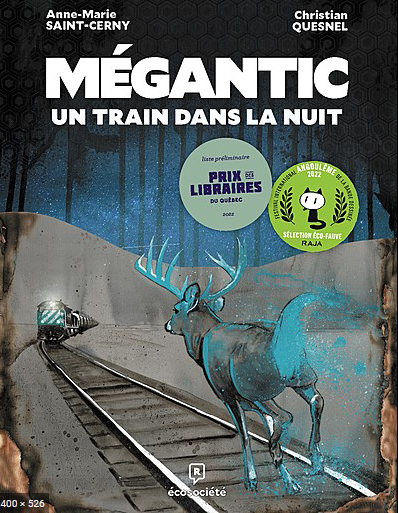
We have all heard of the tragedy experienced by the inhabitants of Lac-Mégantic in 2013, when a driverless oil train from the CP railway company pulling hundreds of cars of explosive petroleum derails in the middle of the night, explodes and kills 47 inhabitants of the city.
The comic book (or graphic novel according to some) “Mégantic – Un train dans la nuit ” adds to the information that we already knew about this tragedy. It also exposes several key pieces of information overlooked by the media.
Author Anne-Marie Saint-Cerny worked for years on the file and, in order to convey the content and the emotions in images, enlisted the help of Christian Quesnel. The result is extremely interesting. The formula works: the drawings are very precise, the layout leaves room for the reader to reflect on the events, the colours are appropriate.
In the train explosion in Lac-Mégantic, there are multiple factors to consider, among others:
1) Executives of the CP company making catastrophic choices.
2) As always, a desire to meet the demands of shareholders. There is a reduction in staff and the company self-assesses when it comes to safety.
3) One driver only is allowed for a train carrying hundreds of tanks of explosives.
4) Politicians agree to the new cuts proposed by the company.
5) There is some magical thinking involved: if something goes wrong with the driver, the train stops on its own thanks to a mechanism which, however, is always likely to fail eventually.
6) Dated rails.
7) The transport of dangerous goods is granted to the MMA, a company with a dubious reputation .
8) The DOT-111 tanks are too fragile for hazardous materials and targeted in more than 25 surveys.
9) There is an agreement to tamper with the oil bill of lading. Instead of indicating the code PG1 (the most dangerous, the most explosive) as it should be, it is instead PG111 (not dangerous) that is written.
10) The lead locomotive is terribly worn.
11) The driver reports a problem with his old locomotive. He is ordered to continue on his way.
12) In Lac-Mégantic, the train is heating up. The driver is ordered to apply the brakes and let the engine run. The driver is then allowed to leave the premises and go to bed. This is one of the repercussions of allowing a single driver on a train.
13) During the night, a fire starts on the lead locomotive, the one that had problems. The firefighters shut down the engine. “By turning off the engine, the air pressure in the air brakes is released. Eventually, the train will start to move on its own and descend the slope towards Lac-Mégantic.”
With just one driver gone to sleep somewhere, there are now 5,000,000 litres of explosives starting to move on the rails and no one will stop them.
“Firefighters believe they are fighting low flammable oil. They are unaware that the CP and World Fuel have falsified the papers, camouflaging their oil classified as the most explosive and dangerous.” There are 47 dead, including several suicides.
Now that there has been a disaster, those involved directly or indirectly are passing the buck, as is the custom in tragedies. The graphic novel mentions, at the political level, the names of Denis Lebel, Lisa Raitt, John Baird and later Marc Garneau. At CP, the author mentions Hunter Harrison. The MMA’s CEO Edward Burkhardt is also mentioned.
Changes happen, but not the ones you would think…
Naomi Klein analyzes the “shock strategy” devised by Milton Friedman. In step 1, “we take advantage of what the population while it is still dazed: they will not be able to oppose what we want to impose on them.” The zoning is being quickly changed to include the expropriation of houses that are totally outside the disaster-affected area. There are some people who are interested in these properties…
In step 2 of the “shock strategy”, we “use the excuse of mandatory decontamination to wipe out the Old World. Excluding the population from the scene of the tragedy, so that they cannot cling to it, so that there is no going back. “
Finally, step 3: “Faced with a population whose shock has been exacerbated by the destruction of its landmarks and habits, we can launch a reconstruction or reinvention which will be received with resigned acceptance“. We have the case of people living in Fatima, a remote area spared by the disaster: owners must quickly sign their expropriation or they shall lose everything. When the former owners are finally gone, a Jean Coutu pharmacy comes to settle on the vacated land.
On the legal side, the small players are targeted and the investigation is limited as much as possible. Takeovers are carried out and returns to shareholders multiplied.
The book flaunts some of the political and entrepreneurial maneuvers aimed at protecting the railway companies. Even at the dawn of 2022, eight years later, the rails still pass through downtown Lac-Mégantic.
“MMA-Canada, essentially bankrupt, has paid nothing and has not been sued.“
“Nothing has changed in rail laws in Canada since the tragedy: companies self-regulate, self-monitor and, in the event of an accident, self-investigate. Thus, it was the CP itself that investigated the deaths of three of its employees in an accident in February 2019 in British Columbia. The CP investigator, prevented from investigating, denounced his employer and called for an independent investigation by the Royal Canadian Mounted Police (RCMP) and the Transport Safety Board (TSB), an investigation immediately accepted by the chief investigator responsible for the case at the TSB. That same day, this TSB investigator was dismissed from his post. The CP investigator concluded on a CP no-fault.”
Title: Mégantic – Un train dans la nuit
Author: Anne-Marie Saint-Cerny
Edition : Écosociété, 2021
ISBN : 978-2-89719-686-8
Hostage
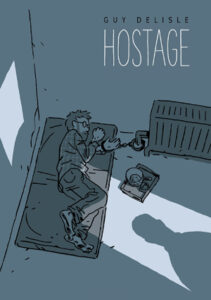
Guy Delisle took fifteen years to write this graphic novel. He tells the story of the kidnapping for ransom (K&R) in 1997 of a French citizen, Christophe André, while he was working for a medical NGO in the Caucasus region.
Faithful to his habits, this Quebec author offers us a fascinating and humane narrative. A work that looks at a real life story often adds tension, when properly put together. This is what happens with the work of Guy Delisle. This 428-page graphic novel can be read in one sitting.
As it often happens in dramatic events, humans discover in themselves more character and strength that enable them to cope with abuse, loneliness and stress.
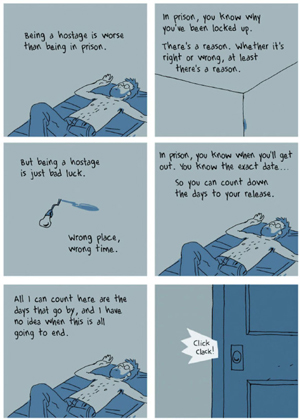
The pace and the quality of the drawings and the script make it easy for the reader to dive into the story and imagine themselves in the place of the captive. Would the decisions made by the hostage also have been made by the reader? Would he have used other means to deal with his captivity?
I discourage the reader from trying to discover the conclusion of this story before starting to read the book. Resist this temptation, the read is worth the effort!
Title : Hostage.
Author : Guy Delisle
Editions : Drawn & Quarterly (25 April 2017)
©2016 et 2017 ISBN-13 : 978-1770462793